Sites: news | india | latam | brasil | indonesia
Feeds: news | india | latam | brasil | indonesia
topic: UCSC
Social media activity version | Lean version
Robotic insect reveals evolutionary secrets of the fastest flapping fliers
- Insects have been incredibly successful in developing ways of flying, with an ultra-fast flapping mode that scientists thought had evolved multiple times over history.
- Now, researchers have genetically traced that mode back to a common ancestor, a major breakthrough in understanding insect flight evolution.
- To confirm their findings, the researchers built a moth-sized robot that mimicked the various ways insects take to the sky.
Nearly half of the world’s flowering plants face the threat of extinction, study says
- A new study estimates that nearly half of the world’s known flowering plants are threatened.
- Scientists built an AI model using plants they know are threatened or safe, then used it to estimate how many others are threatened as well.
- The research team hopes to get more plants included on the IUCN Red List, which helps protect threatened species from habitat loss.
Scientists unearth secrets of the world’s smallest porcupine species
- Scientists conducted the first investigation in 22 years into the Roosmalen’s dwarf porcupine, an elusive forest porcupine in Brazil.
- With the fresh tissue of a new specimen, the scientists used the porcupine’s DNA sequence and physical traits to better trace its relationship to other species.
- Their discovery shows the porcupines are more widespread in the Amazon than previously thought, a hopeful sign of their resiliency despite ongoing deforestation.
Ecologists help migratory birds adapt to climate change
- Warmer and earlier spring seasons cause problems for migratory birds, who return to breeding sites after winter to find that most of their food is already gone.
- Researchers drove European pied flycatchers north from the Netherlands to Sweden, where spring arrives two weeks later and food supplies peak at the right time for newly hatched chicks.
- Birds born in Sweden flew back to the same northern sites on their own to breed, showing that scientists might be able to help some species adapt to climate change.
Congo’s waters are hotspot for endangered sharks & rays, reveals data from artisanal fishers
- A new shark census off the coast of the Republic of the Congo relied on hard-earned trust between researchers and artisanal fishermen.
- The team found endangered sharks and rays on potential nursery grounds, including juveniles and two species thought to be gone from the region.
- The authors recommend conservation strategies to protect endangered species without harming the livelihoods of Congolese fishermen.
Do tree-planting projects on grasslands increase fire risk?
- Global tree-planting initiatives, aimed at storing carbon from the atmosphere, could include plantations in fire-prone African savannas.
- 58% of tree plantations grown in South African grasslands between 1980 and 2019 burned, polluting water and releasing carbon dioxide back into the air.
- As efforts to plant trees for carbon storage in Africa expand, researchers suggest cutting fossil-fuel emissions would be a better approach — but scientists are hotly debating the issue.
Llama herding helps community in Peru recover from a melting glacier
- Melting glaciers in Peru leave behind barren rocky soil that can take decades to be productive again, and can harm local communities with acidic water run-off.
- Llamas can revitalize these landscapes much more quickly through their waste and by dispersing seeds for plants to regrow.
- Researchers are partnering with communities and llama herders in the Andes to improve soil quality and plant productivity as more ice retreats.
North Atlantic orcas reveal the troubling persistence of toxic ocean pollutants
- As the top predators in the ocean, killer whales suffer from the magnifying level of pollutants that build up in the marine food web.
- Scientists found that North Atlantic orcas feeding on marine mammals carry significantly higher levels of pollutants than orcas that eat fish.
- Levels of polychlorinated biphenyls in the orcas’ blubber are ten times higher than the toxic threshold for these dangerous household chemicals.
Discriminatory U.S. housing policies still affect bird sightings 90 years later
- Researchers have found far less data on bird sightings in neighborhoods impacted by discriminatory housing policies in the United States since the 1930s.
- Even with the rise of digital citizen science platforms like eBird in the last two decades, the information gap on bird species between wealthy and impoverished areas has gotten much worse.
- This legacy of environmental injustice in the U.S. prevents ecologists from having a reliable picture of biodiversity in major cities.
Killings of Bornean orangutans could lead to their extinction
- Human actions have led to the deaths of more than 100,000 Bornean orangutans since 1999, mainly for crop protection, bushmeat or the illegal wildlife trade.
- For the first time in 15 years, researchers surveyed residents of Kalimantan, the Indonesian section of Borneo, to find out why people kill the great apes and whether conservation projects help protect them.
- Researchers found that killings seriously threaten orangutan numbers, and that conservation projects have not yet helped.
Bright, unique colors can put tropical songbirds at greater risk
- Scientists measured color diversity and uniqueness in songbirds and other perching birds to prove what’s been said since Darwin’s time: The tropics are the most colorful place for these birds.
- Because the global pet trade appears to target groups of related, uniquely colored songbirds, researchers believe an additional 478 species may be at risk next.
- Losing such birds may dull nature’s palette of colors and leave fewer charismatic species to inspire conservation.
Wildfires are climbing up the snowiest mountains of the western U.S.
- Forest fires are getting larger and hotter in the western U.S., shrinking the mountain snowpacks vital to communities and ecosystems.
- When a wildfire burns on mountain slopes, snow that falls later in the winter is more exposed to sun and wind, making it melt or evaporate faster and earlier than ever before.
- Burned land is recovering more slowly as the region warms, leaving less water for trees and plants to regrow and increasing the risks of erosion and flooding.
Chimpanzee nut cracking leaves telltale marks on stones, providing clues to human evolution
- Groups of chimpanzees in West Africa use stone tools in distinctly different ways to crack open nuts.
- Researchers used 3D scans to trace wear patterns on the tools, called “hammerstones” and “anvils.”
- The different tool uses may help archaeologists identify signs of early stone tool technology in human ancestors more than 3 million years ago.
How many ants live on Earth? At least 20 quadrillion, scientists say
- Biologists scoured hundreds of studies of ant populations around the globe to arrive at a startling new estimate of their numbers: 20 quadrillion, or about 2.5 million for every person on Earth.
- Even this estimate is low, the scientists say, as it does not account for ants living underground, and there is not much data from Northern Asia and Central Africa.
- Because ants are vital to the health of our ecosystems, researchers stress the importance of learning more about their abundance and their response to environmental change.
If you build it, the amphibians will come: Swiss researchers show new ponds boost species at risk
- Local authorities and nonprofits created hundreds of new ponds on farms and in forests in a Swiss state.
- Two decades of monitoring 12 amphibian species showed that 10 of them expanded into more ponds, likely increasing their population numbers.
- The strategy is promising in similar settings, but may not be applicable everywhere.
Melting ice created the perfect storm for a rapidly acidifying Arctic Ocean
- The Arctic Ocean has grown more acidic at a surprising rate in recent years, three times faster than the rest of the global ocean.
- Melting sea ice has exposed the top level of the Arctic Ocean to air rich with carbon dioxide, creating a layer that sopped up carbon from the atmosphere.
- Increased acidity may hamper the ability of marine organisms to build their shells, causing ripple effects through the Arctic food web.
Climate damage from Bitcoin mining grew more than 125 times worse in just five years
- The negative climate impacts of mining the cryptocurrency Bitcoin have grown rapidly over time, with carbon emissions per coin multiplying 126 times from 2016 to 2021.
- During that window, the climate damage of mining one Bitcoin averaged 35% of a coin’s value, similar to the environmental costs of unsustainable products like crude oil and beef.
- Reducing Bitcoin’s massive carbon footprint may require international regulation unless the cryptocurrency shifts to a more energy-efficient mining system.
Indigenous knowledge guides the conservation of culturally important plants
- The Karuk Tribe in northern California has traditionally managed plants for food, fiber, and medicine, but decades of fire suppression and climate change are threatening culturally important species.
- Researchers partnered with Karuk Tribe land stewards to understand how fire suppression and drought have affected the quality of four plants central to their food security and culture.
- In this long-term collaborative study, Indigenous Knowledge expands on western science methods, assessing the ecological health of plants and their cultural usefulness.
Some tree-dwelling primates may adapt more easily to life on the ground, massive study shows
- As deforestation and climate change alter rainforest habitats, monkeys and lemurs that normally live in trees are risking encounters with predators to spend time on the ground.
- Species with diverse diets, smaller body masses, and larger group sizes may adjust to terrestrial life more successfully than others.
- The huge international study drew from more than 150,000 hours of observations of 47 species in Madagascar and Central and South America.
Extinction not only threatens primates—their parasites are in danger, too
- Primates threatened with extinction have highly specific parasites that will likely vanish if their hosts go extinct.
- Parasites play essential roles in ecosystems, but most are so understudied that scientists don’t understand the consequences of losing them.
- If in peril due to a diminishing number of hosts, parasites may try to jump to new host species—potentially triggering unforeseen infections.
El Niño takes a toll on southern right whales in the Atlantic Ocean
- Southern right whale populations near Argentina have suffered surprising losses during recent El Niño years.
- Intense warmings in 1997-98 and 2015-16 each killed 4 to 5 percent of right whales in the southwest Atlantic Ocean, researchers estimate.
- If El Niño events worsen, models suggest the encouraging recovery of southern right whales could stall or even reverse.
Potty-trained cows? Teaching cattle where to urinate could help reduce greenhouse gases
- Cows can learn to control where they urinate, scientists showed in a small study.
- Urine from cattle ultimately produces nitrous oxide, a harmful greenhouse gas.
- Scaling up this training method could reduce the environmental impacts of large farms.
Geneticists have identified new groups of tiger sharks to protect
- New genetic studies revealed at least two distinct groups of tiger sharks in the Atlantic and Indo-Pacific ocean basins, plus a third smaller population near Hawaii.
- These results are a mild surprise, due to the versatility and long swimming ranges of tiger sharks.
- Fisheries managers should take precautions to protect these distinct genetic populations, researchers urge.
Insects and other invertebrates on tropical islands face challenges as development and tourism expand
- Oceanic islands host 50 percent of the world’s endangered species, but human activities can greatly disturb these isolated ecosystems.
- The number and diversity of insects and other invertebrate species decrease on islands dedicated to urban development or tourism, according to a new study in the Maldives.
- Fragmented habitats take a toll on these species on urban islands, while pesticides are the suspected culprits on tourist islands.
Some hummingbird females display male coloring to avoid being harassed
- Hummingbirds with brightly colored feathers typical of males are harassed by other birds less frequently than those with drab female-colored feathers.
- Male coloring in one species of hummingbird gives a social advantage to females displaying that color pattern.
- This study is the first to show these behaviors in action with live hummingbirds.
Jaguars in Mexico are growing in number, a promising sign that national conservation strategies are working
- The first surveys to count jaguars in Mexico revealed a 20% increase in the population from 2010 to 2018, up to 4,800 animals.
- Conservation strategies targeted the most urgent threats to jaguars, and prioritized protecting wildlife preserves and natural corridors.
- Mexico’s National Alliance for Jaguar Conservation united the government, people living near protected areas, and the private sector in plans to conserve the iconic species.
“Earthshine” from the Moon shows our planet is dimming, intensifying global warming
- Earth’s brightness, as seen from space, has dropped significantly over the past two decades.
- When the planet reflects less light, more sunlight reaches the ground and the sea, warming the atmosphere.
- A natural rise in Pacific Ocean temperatures in 2015-2017 made Earth even dimmer by reducing bright clouds over the western Americas, a new study concludes.
Carnivores avoid rush hour by taking to roads at night
- Large carnivores avoid people by steering clear of roads during the day, but they often travel by road at night.
- Avoiding humans is a higher priority than avoiding other carnivore species.
- Humans may also be altering predator-prey relationships by making large carnivores more nocturnal.
Honey bees find food more easily in cities, thanks to abundant urban gardens
- In London, western honey bees travel shorter distances to find their meals in metropolitan areas than in agricultural ones.
- A rich supply of gardens and decorative flowers provides ample nectar close to urban hives.
- Adding native flowers and similar foraging hotspots near open fields would help support bees in intensively farmed areas.
Lasers reveal steep decline in ecosystem function of degraded Amazon forests
- Large portions of the Amazon rainforest are degraded by human activities, such as patchy smallholder farming, timber extraction, and burning.
- Airborne laser scans paired with an ecological model show that these areas store less carbon, carry less water, and are much more fire-prone.
- During periods of extreme drought, intact forests also run out of water and become as hot as degraded forests, stressing the entire ecosystem
In China, public support grows to rein in the wildlife trade in the wake of the pandemic
- After the December 2019 outbreak of the coronavirus pandemic, Chinese researchers surveyed the Chinese public on their opinions of wildlife consumption and trade.
- An overwhelming majority supported stricter policies and legislation to protect wildlife.
- NGOs based in China report parallel findings that public awareness and support of wildlife conservation has increased dramatically. They see the pandemic as a promising opportunity to make substantial changes
Humanity’s construction footprint in the seas amounts to 32,000 square kilometers
- A new study puts the physical footprint of marine structures globally into numbers for the first time.
- Researchers conservatively estimate that 32,000 square kilometers (12,000 square miles) of the global seafloor is covered by human-made structures.
- The map provides a jumping-off point for spatial planning to minimize the negative impacts of marine construction on local ecology.
Coronavirus risk grows as animals move through wildlife trade
- Animals consumed by people in Vietnam are increasingly likely to carry coronavirus as they move from the wild to markets to restaurants, a new study shows.
- The animals with the highest rates of infection are most likely to come into contact with humans.
- When animals are confined in crowded and stressful conditions, it makes it even easier for the virus to spread.
The glaciers of the Greenland Ice Sheet are running away
- Greenland’s massive ice sheet will continue shrinking even if snowfall rates return to the higher levels of decades ago, when the ice sheet was stable, a new study shows.
- Rates of ice loss climbed dramatically in the early 2000s before settling at a higher, sustained state of decline.
- For each kilometer that Greenland’s glaciers retreat, their rate of ice loss speeds up by 4 to 5 percent—a bleak trend that will accelerate sea-level rise.
The New Guinea singing dog, once thought extinct, is alive in the wild
- DNA analysis of three wild dogs living at high altitude on New Guinea reveals that they are part of the same population as captive New Guinea singing dogs.
- These findings confirm that New Guinea singing dogs are not extinct in the wild as previously thought.
- New conservation methods are now being considered to protect what some consider to be the world’s rarest wild dog.
Why did the woolly rhino go extinct?
- Genetic analysis of the remnants of 14 woolly rhinos shows that a warming climate, not hunting, probably killed them off 14,000 years ago.
- The numbers of woolly rhinos remained constant until close to their extinction, and far after humans had migrated to their territory in Siberia.
- Genetic mutations suggest that the rhinos were so adapted to living in cold conditions that they could not survive when the climate rapidly warmed.
Big mammals are at risk in the world’s poorest countries, even within parks
- Forty years of global conservation research reveals that mammal populations are declining due to hunting in poor countries and within preserved areas, especially in Africa.
- Large mammals are particularly vulnerable, since their slow growth and reproduction rates make it harder for them to bounce back from poaching.
- In Asia, protected areas with tighter enforcement actually have higher rates of population loss, likely because the most sought-after species only exist within these strict enclaves.
Clean up efforts won’t solve the plastic pollution crisis in the world’s seas
- A model simulating a device touted to clear plastic from the “Great Pacific garbage patch” shows that it would collect much less than 1 percent of the ocean’s plastic pollution by 2150.
- The study was the first to quantify the device’s ability to remove marine debris.
- A more comprehensive approach to reducing plastic, including holding corporations responsible, is needed in addition to efforts to scoop trash from the sea.
Are industrial chemicals killing rare whales and familiar dolphins?
- Dozens of whales and dolphins that beached themselves on the U.S. Atlantic Coast contained high levels of pollutants and heavy metals in their blubber and liver tissues, a new study shows.
- For the first time, scientists detected the widely used antibiotic Triclosan and the popular herbicide Atrazine in rare species that spend their lives hundreds of kilometers offshore.
- While the findings suggest these toxins may contribute to the demise of marine mammals, more research is needed to determine direct cause and effect.
Scientists in Costa Rica are growing new corals to save reefs
- For three years scientists with Raising Coral Costa Rica have been snapping off coral pieces from existing reefs to grow them in an underwater nursery.
- The team is using tested techniques and experimental ideas to grow coral and revive ancient reefs in Golfo Dulce, southwestern Costa Rica.
- Their findings are helping to restore local ecosystems, and could help researchers who hope to revive reefs in nearby countries. The species of the Golfo Dulce, when compared to a lot of the world’s reefs, may hold extraordinary clues about resilience to changing ocean conditions.
- As the race to save our oceans against a changing climate accelerates around the world, knowing how to rebuild one of its foundational components, coral reefs, may be one way that scientists can help them survive in a warming world.
Protecting living corals could help defend the Great Barrier Reef from ocean acidification for decades
- For the first time, researchers have studied the impact of ocean acidification on coral reefs with a device that allows them to increase levels of carbon dioxide on living coral for months at a time.
- Corals exposed to higher levels of carbon dioxide sustained more damage than those in aquarium experiments because fish, sponges, and other native organisms grazed on the fragile reefs.
- However, living corals were more resilient than scientists expected, providing a promising buffer against the impacts of climate change.
Amazon primates face barriers in responding to climate change
- Climate change will make the current ranges of most Amazon primates uninhabitable in the coming decades, forcing them to move.
- But primates face barriers to dispersal, such as rivers and deforestation, which can limit their ability to migrate.
- If species aren’t able to find new habitats, the populations, as well as the habitat they support, will suffer.
Camera traps yield surprises in West Africa’s largest protected area
- The first camera study of wildlife in Burkina Faso and Niger has shown that the main human activities in the region’s largest protected area are gathering resources and grazing livestock.
- Poaching remains a threat, but it occurs less frequently than other human pressures on the region’s wildlife.
- The findings suggest possible changes in management strategies for three national parks in West Africa.
Moon and Earth’s magnetic field guide European eels on their epic migration
- European eels use an electromagnetic “sixth sense” to navigate during their long migration, two new studies propose.
- The electrical “shadow” of a new moon may help eels cross the continental shelf of Europe to shore. Then, in the brackish waters of an estuary, young eels can imprint on the unique magnetic signature to navigate upstream.
- Piecing together the eels’ directional cues could help fisheries managers create more effective conservation plans for this critically endangered species.
Heat stress is causing desert bird populations to collapse
- Sites in the Mojave Desert in the western U.S. surveyed by ecologists a century ago have lost an average of 43 percent of their breeding bird species.
- New research suggests higher temperatures have increased the daily water needs of birds, which could decimate their populations if climate change worsens.
- The most vulnerable birds are larger, carnivorous species such as turkey vultures and prairie falcons that get most of their water from prey.
Beneficial and harmful fungi are at the root of forest diversity
- If there are many trees of a given species in a tract of forest, a new tree of that same species has a harder time thriving in the same area.
- This “rare-species advantage” produces diversity in forests.
- In a Chinese subtropical forest, researchers showed that the balance between beneficial and harmful soil fungi controls the rare-species advantage.
- This study provides the first look into the mechanism behind the strength of the rare-species advantage and adds to an understanding of how all forests develop.
Female gorillas recognize and respond to contagious disease
- An infectious skin disease causing bright red facial lesions affects how female gorillas decide to change social groups, researchers have shown.
- Decade-long observations of nearly 600 gorillas in the Republic of the Congo revealed females are more likely to leave groups with severely diseased females or an infected silverback male.
- By reducing contact with sick individuals, females can decrease the risk of being contaminated and prevent further spread of the infection in the population.
Rapid genetic test traces spread of fungus that kills frogs, reveals new strain in Southeast Asia
- The chytrid fungus has devastated frog populations worldwide, but some variants are especially dangerous.
- Researchers collected 222 frog skin swabs from six continents to map the global distribution of these strains.
- A new and targeted genetic screen uncovered an unknown lineage in Southeast Asia and regions where co-existing variants could combine into deadly hybrids.
- Rapid skin swabs could help scientists unravel how the fungus became so deadly in recent decades, leading to tighter laws restricting the international transport of frogs.
Pangolins are a victim of political instability in South Sudan
- Researchers have confirmed seven cases of pangolin trafficking in South Sudan, with much higher numbers likely.
- High demand for pangolin scales and meat in Asian markets has brought pangolin species in Asia — and now in Africa as well — to the brink of extinction.
- Stronger wildlife monitoring and trafficking enforcement are essential in an African country filled with invaluable species and political conflict
Gardens with too many nonnative plants threaten populations of insect-eating birds, study finds
- Researchers teamed up with community scientists to explore how nonnative plants in yards and gardens affect the breeding success of chickadees, a common insect-eating bird in the U.S.
- In gardens with less than 70% of native plants by biomass, chickadee populations crashed, because the insects they usually eat cannot live on nonnative trees and flowers.
- Landscaping with native plants helps resident animals thrive by sustaining balanced populations of their prey.
Ground-feeding birds in Southeast Asia may be going extinct outside protected areas
- Quails, partridges and pheasants, together called galliforms, are becoming increasingly restricted to protected areas in Southeast Asia.
- Five species of galliforms, including three endemics, might no longer survive outside protected areas, a new study predicts.
- Many local extinctions have occurred in Sumatra, where habitat loss appears more pronounced.
- Researchers find that protected areas are becoming increasingly isolated and are not integrated into the wider landscape.
Secondary forests in Costa Rica are re-cleared within decades
- Secondary forests in Costa Rica, which are important for the country’s reforestation and climate change goals, don’t last long enough to recover previously lost biomass and biodiversity, a new study shows.
- Within 20 years, half of the secondary forest in a region of Coto Brus was cleared. After 54 years, 85 percent of these young forests were gone. The results contradict national reports of increasing forest coverage.
- Costa Rica should shift from its current commitment to restore 1 million hectares of degraded land by 2020 to longer-term commitments to ensure the persistence of young forests, researchers propose.
As the mammal tree of life suffers hits, should we prioritize which species to save?
- More than 300 mammal species have gone extinct since shortly before the last ice age, a loss of more than 2.5 billion years of evolutionary history across all ancestral lines, a sweeping study reports.
- Even in the best-case scenario — we completely stop climate change and extinctions within 50 years — evolution would need at least three million years to redevelop that lost biodiversity.
- Choosing to save the most distinct at-risk species is one way to minimize ongoing damage to the mammal tree of life.
Tiny bits of ocean plastic threaten the survival of sea turtle hatchlings
- Smaller and smaller pieces of single-use plastic are ending up in the stomachs of juvenile sea turtles off the coast of Florida.
- Of 96 stranded sea turtle hatchlings collected in a study, more than half died, while all the survivors passed plastic fragments through their bodies.
- Increasing amounts of plastic entering the ocean and disintegrating into microscopic bits have increased the risk that sea turtles will choke on or struggle to pass plastic debris, making it harder for them to reach adulthood.
Deadly parrot virus found in native birds from Asia and Africa
- Researchers have found beak and feather disease virus (BFDV) in wild parrots from eight new countries.
- BFDV spreads through captive parrots worldwide, but its prevalence in wild species is unknown. Infected escapees could threaten native parrots, especially small populations.
- Parrots in West Africa carried viruses that probably spread from other countries, showing that the human pet trade market has made the BFDV epidemic worse.
- New regulations of live parrot trades are essential to protect susceptible species, researchers say.
Mosses could help rapidly detect pollution
- Researchers have developed a method that uses mosses to rapidly and cheaply detect sulfur dioxide, a common pollutant from burning fossil fuels.
- The method uses a camera to monitor the change of moss leaves from green toward yellow that is triggered by sulfur dioxide within 10 seconds.
- Scientists envision using mosses to monitor harmful gases in both indoor and outdoor environments.
- Mosses have advantages over traditional sensors, such as not needing to be replaced after detecting the gas.
Bits of DNA in ocean water can reveal white sharks swimming nearby
- Environmental DNA in small samples of seawater can show whether white sharks are in an area.
- In a pilot study, researchers found genetic material from white sharks along two southern California beaches where drones and tagging data indicated white sharks were present.
- Refining this technique could minimize dangerous human-shark interactions and improve shark conservation efforts.
Guam’s invasive bird-destroying snake less unique than thought
- Researchers had previously blamed Guam’s devastating brown tree snake invasion on the snake’s uniquely toxic venom.
- This venom, irditoxin, is actually present in all snakes within the cat-eye family, a new study shows, leading researchers to re-evaluate the brown tree snake’s success.
- The snake has killed most of the island’s native bird species, threatening the ecological future of this tropical island.
Tropical trees grow most easily where they are rare
- Researchers have long puzzled over why tropical forests contain such diverse species of plants and animals.
- A new study, examining the distribution of a common flowering tree in Panama, found confirmation for a decades-old hypothesis.
- This hypothesis maintains that as a species becomes more common, its natural predators limit its spread, thereby creating diversity.
- Satellite images over a 10-year period provided the evidence needed to prove the validity of this idea.
Light pollution lures nighttime pollinators away from plants
- Over the last two decades, nighttime light emissions in North America and Europe have increased by more than 70 percent.
- This artificial light lures moths and other insect pollinators away from plants, a new study shows.
- This effect may also make daytime pollinators less efficient, posing a further threat to plants and global food security.
Waning plantain yields in rural Cameroon hurt college attendance
- Plantain yields in Cameroon have declined 43 percent in the 20 years since 1991 because of increasing temperatures and dryness.
- Villagers use proceeds from crop sales to pay for higher education, but this income is dwindling.
- As a result, college attendance rates have declined by six months, on average, during this period.
Raising beef cattle on grass can create a higher carbon footprint than feedlots, new study suggests
- Feedlot cattle have a smaller carbon footprint than pasture-raised cattle because they grow faster and produce higher meat yields, a new study has found
- This is important for countries that must balance the demand for beef with maintaining a fragile environment.
- However, grassland ranchers argue this is a short-sighted approach to take, and that, holistically, grass-fed cattle are better for the environment.
Mammal diversity may increase carbon storage in rainforests
- Having a diverse mix of mammals may play a more pivotal role than expected in the carbon cycle of tropical forests, by feeding microbes that lock the carbon from food scraps in the soil.
- Hundreds of indigenous research technicians collected data for this study across an area roughly the size of Costa Rica.
- Conserving mammal species will become increasingly important in efforts to protect the health of rainforest ecosystems, researchers suggest.
Extreme seasonal changes in Amazon river levels threaten forest conservation by indigenous people
- The Amazon has experienced intense floods and droughts for the past 10 years, a likely effect of climate change.
- Surveys taken of animals between 2009 and 2015 showed terrestrial mammal populations dropped by 95 percent during intense floods, whereas aquatic animals suffered dramatic declines during an extreme drought.
- Scientists fear these seasonal extremes will drive the Cocama people of Peru out of the forest, depriving it of its primary conservationists.
The curious case of the phantom hippo teeth
- Hippo ivory is an affordable alternative to elephant ivory, whose international trade is prohibited by many countries.
- The reported export and import numbers of legal wildlife trade in the CITES database are dramatically mismatched for some species, including the numbers for hippo teeth.
- An updated population estimate for hippos could indicate how much illegal poaching for their ivory is threatening them.
Plastic in the ocean smells like junk food to hungry anchovies
- Researchers created blends of algae- and bacteria-coated plastic, clean plastic, and plain seawater to test whether anchovies are drawn to the scent of plastic debris in the ocean.
- The odors of plastic pieces coated in algae or bacteria sparked vigorous feeding behavior in the fish.
- By eating plastics, anchovies and other baitfish could become toxic to the animals and people who rely on them for food.
Storytelling empowers indigenous people to conserve their environments
- Indigenous storytelling is a powerful tool for preserving biocultural diversity, conservation scientists propose.
- Conservationists should rise above the field’s historic malpractice by listening to stories and truly collaborating with indigenous people.
- To successfully collaborate, conservationists must regard indigenous knowledge as valid, act in accordance with standing traditions and maintain a humble willingness to learn.
Long-term droughts are throttling growth in Hawaiian forests, finds airborne laser-based study
- Long-term declines in rainfall on the Big Island of Hawaii have added up over time to make forests shorter and less green.
- Data from satellites and airplane surveys showed that forest canopy greenness decreased twice as much in areas where annual rainfall had steadily declined since 1920.
- Long-term drying trends in other parts of the world may have far-reaching impacts on forests.
Distinctive sperm whale cultures reveal dramatic population shifts in the Galápagos
- Researchers studied distinctive communication clicks among sperm whales to track several cultural clans in the Pacific Ocean.
- Two clans dominated the waters near the Galápagos decades ago, but whales from two different clans have since moved in from across the Pacific basin.
- Managing sperm whales may require tracking their populations culturally, rather than geographically.
Female chimpanzees wait for their turn at the top of the social pecking order
- By studying decades of interactions, scientists have documented that female chimpanzees line up in a pre-determined social order.
- Females wait patiently for higher-ranked females to die off before moving up the social ladder.
- Once a mature female enters the social queue, her ranking remains unchanged until elder females are out of the picture.
Small-scale farming threatens rainforests in Sumatra
- A recent study probed the ecology of small farms in Sumatra, showing that small-scale farming can be just as damaging to the environment as large plantations.
- Small-scale coffee growers in Latin America have sustainable practices because they work in cooperatives with direct access to markets for rainforest-certified products.
- For smallholder farming of oil palm and rubber to become sustainable in Indonesia, farmers will need to form similar cooperatives and grow rainforest-certified crops.
Humpback whales learn habitat loyalty from their mothers, Alaskan study shows
- Marine biologists studied relationships among humpback whales in Glacier Bay and Icy Strait, Alaska, over a 30-year period.
- The whales’ loyalty to their feeding grounds is passed down from mothers to calves and persists through the generations.
- North Pacific humpback whales are making a comeback, and the new study shows how critical it is to protect their key habitats.
Over-fertilization diminishes the biodiversity of global grasslands
- Grasslands are critical global ecosystems, but pollution from agricultural fertilizers and nitrogen-laden smog threatens to dump too many nutrients onto the grasses.
- Ecologists applied various fertilizers to grassland plots at 45 sites on five continents annually and measured biodiversity and plant growth.
- Excess nutrients decreased biodiversity more and more over time, even when plant growth remained constant.
Yosemite’s yellow-legged frogs bounce back from near extinction
- A recent study found a large-scale increase in the endangered Sierra Nevada yellow-legged frog in Yosemite National Park in California.
- The sevenfold increase is due to fewer predatory trout and greater resistance to the chytrid fungus.
- The frogs have a long way to full recovery, but may be more resilient than researchers previously thought.
Large branches fall from the western Amazon rainforest canopy at a surprising rate
- Scientists determine how climate change affects forests by monitoring how carbon cycles through trees.
- Airplane surveys show that when trees in the western Amazon lose their branches, they release almost as much carbon dioxide into the atmosphere as when trees die.
- Branchfall is now an important factor in accounting for how carbon moves in and out of forests.
The beloved Hawaiian honeycreeper birds are at risk of extinction from avian malaria
- A warmer climate has allowed mosquitoes that carry avian malaria to invade honeycreeper habitats on the Hawaiian island of Kaua’i.
- Honeycreeper populations have decreased as much as 98 percent over the past 15 years.
- Unless ecologists intervene, the birds may vanish in 10 to 30 years.
Elusive elephants: Determining where 19th century ivory trade victims roamed
- African elephant poaching escalated in the 19th century and still continues today.
- New research has helped to map out the origins of East African poached elephants from the 19th century.
- The research techniques can contribute to conserving modern-day elephants at risk of poaching and/or habitat loss.
New dams may expose Canadian seafood consumers to higher levels of neurotoxin
- Methylmercury, a dangerous neurotoxin, can build up in the bodies of marine mammals and fish, threatening the humans who eat them.
- New research suggests dams and reservoirs in sub-Arctic regions may release methylmercury downstream.
- Native residents who depend on hunting and fishing are especially at risk.
Preservatives from cosmetics build up in the bodies of far-flung marine mammals
- Scientists have detected parabens, a common cosmetic preservative, in marine mammals from coastal areas of the United States.
- The chemical concentrations were highest in coastal animals like dolphins and sea otters, but also showed up in polar bears in remote regions.
- Researchers don’t yet know how toxic these chemicals are, but parabens can disrupt hormones in the body.
Poisonous amphibians may be more likely to go extinct
- Globally, amphibians are going extinct at alarming rates.
- New research indicates amphibians that use poisons or other chemical defenses may have higher historic extinction rates than those without such defenses.
- Human-caused factors may now be overpowering historic extinction rates.
Birds, butterflies, and flowers might be blander than expected in the tropics
- Scientists have commonly believed life is more colorful in the tropics.
- A study tested that assumption by measuring color properties in hundreds of species of butterflies, birds, and flowers spanning many latitudes in eastern Australia.
- The most vivid organisms dwelled in temperate regions instead of tropical ones, but whether that’s true elsewhere is still up for debate.
Ocean protections drift behind those on land, but science can help
- A new paper reports only 3.6 percent of oceans are protected, but the rate of protection is increasing.
- The authors describe different types of marine protected areas and argue those without any fishing are most effective.
- The paper lists several ways policymakers can create robust reserves, like involving ocean users early in planning.
Small, controlled fires are the only way to prevent large wildfires, researchers argue
- Stamping out forest fires indiscriminately leads to denser trees and debris in many forests, fueling unusually large wildfires.
- Recent U.S. wildfires have gained so much power that scientific models can no longer predict their behavior.
- A new paper urges the public to demand a correction in this trend by changing how forest fires are managed
Invasive species hop on tourists worldwide
- Foreign plants, animals, and even bacteria can devastate ecosystems where they don’t belong.
- New research finds that tourists introduce unwelcome species around the world.
- To keep wilderness pristine, personal awareness is the first step.
Vanishing vultures: Africa’s fetish and bushmeat trade is driving its scavengers to extinction
- A study shows that the trade of vulture bodies and parts is the main factor in the birds’ approaching extinction in Africa.
- Many Africans use the birds’ bodies because they believe certain body parts bestow clairvoyant abilities.
- Poachers use powerful pesticides to poison large animals, killing vultures that feed on the tainted carcasses.
Air pollution causes millions of preventable deaths in East Asia, say scientists
- Research suggests that exposure to air pollution kills more than 3 million people prematurely, especially in South and East Asia.
- Residential stoves and furnaces burning coal and biomass produce most of the pollutants in Asia.
- If “business-as-usual” emissions continue, deaths could double by 2050.
Protecting pandas shields other species in China
- China invests millions of dollars to protect giant pandas, but scientists have been uncertain about whether this helps other species.
- New analysis of the ranges of pandas and birds, mammals, and amphibians found only in China’s forests shows major overlap.
- The finding supports the idea of pandas as an “umbrella species,” whose conservation also protects many other animals.
Forests could be a thrifty way to fight ozone pollution
 Planting trees may be a cost-effective way to reduce ground-level ozone, a toxic component of smog that contributes to the deaths of about 152,000 people annually worldwide, according to new research. The study is the first to lay out a practical plan and examine the economic impacts of lowering ozone levels with trees. Scientists used […]
Planting trees may be a cost-effective way to reduce ground-level ozone, a toxic component of smog that contributes to the deaths of about 152,000 people annually worldwide, according to new research. The study is the first to lay out a practical plan and examine the economic impacts of lowering ozone levels with trees. Scientists used […]
Pollinators puzzle to find flowers amidst natural and human fumes
 While unpleasant car exhaust makes us wrinkle our noses, such human-made fumes may pose serious problems to insects searching for nectar. Researchers recently revealed that background odors make finding flowers difficult for pollinators. The study, published in Science, measured how hawk moths (Manduca sexta) pick out the sacred datura flower scent (Datura wrightii) amidst all […]
While unpleasant car exhaust makes us wrinkle our noses, such human-made fumes may pose serious problems to insects searching for nectar. Researchers recently revealed that background odors make finding flowers difficult for pollinators. The study, published in Science, measured how hawk moths (Manduca sexta) pick out the sacred datura flower scent (Datura wrightii) amidst all […]
Tribal violence comes naturally to chimpanzees
 It all went to hell when Jane Goodall started handing out bananas. Within a few years, the previously peaceful chimpanzees she was studying split into two warring tribes. Gangs of males from the larger faction systematically slaughtered their former tribemates. All over the bananas. Or so the argument goes. The idea that feeding the chimps […]
It all went to hell when Jane Goodall started handing out bananas. Within a few years, the previously peaceful chimpanzees she was studying split into two warring tribes. Gangs of males from the larger faction systematically slaughtered their former tribemates. All over the bananas. Or so the argument goes. The idea that feeding the chimps […]
Old fishermen document declining range of the Indus River dolphin
 Reduced river flows below irrigation dams decimate freshwater dolphins Rare photo showing two Indus River dolphins in the wild. Photo credit: Albert Reichert, CC-BY.N The Indus River dolphin (Platanista gangetica minor) is an endangered freshwater mammal found only in the Indus River and tributaries draining the Himalayas. Since 1879, the dolphin—locally known as the bhulan—has […]
Reduced river flows below irrigation dams decimate freshwater dolphins Rare photo showing two Indus River dolphins in the wild. Photo credit: Albert Reichert, CC-BY.N The Indus River dolphin (Platanista gangetica minor) is an endangered freshwater mammal found only in the Indus River and tributaries draining the Himalayas. Since 1879, the dolphin—locally known as the bhulan—has […]
Nano-tags track baby sea turtles during their first few hours
 Miniature acoustic tags allow researchers to track newborn sea turtles during ‘swimming frenzy’ Baby sea turtles vanish after they scamper into the ocean. Years later, juvenile turtles may pop up thousands of kilometers away, but often scientists don’t see them again until they return to their birthplaces to nest on the beach. Now, using tiny […]
Miniature acoustic tags allow researchers to track newborn sea turtles during ‘swimming frenzy’ Baby sea turtles vanish after they scamper into the ocean. Years later, juvenile turtles may pop up thousands of kilometers away, but often scientists don’t see them again until they return to their birthplaces to nest on the beach. Now, using tiny […]
Shark pups may not survive climate change
 Researchers find that warming ocean and acidification could hit young sharks hard Fierce predatory sharks rule the oceans from the apex of the food pyramid. But climate change may be tougher than these marine hunters, a new study suggests. As oceans warm and their waters become more acidic, fewer sharks may survive their infancies. No […]
Researchers find that warming ocean and acidification could hit young sharks hard Fierce predatory sharks rule the oceans from the apex of the food pyramid. But climate change may be tougher than these marine hunters, a new study suggests. As oceans warm and their waters become more acidic, fewer sharks may survive their infancies. No […]
Without draconian measures, global population boom is ‘locked in’
 Little chance of reaching ‘sustainable population’ in next century According to recent projections, the number of people living on Earth could exceed ten billion by the end of this century. Now, a new study has examined what it would take to reverse that unrelenting growth and achieve a sustainable population that is less threatening to […]
Little chance of reaching ‘sustainable population’ in next century According to recent projections, the number of people living on Earth could exceed ten billion by the end of this century. Now, a new study has examined what it would take to reverse that unrelenting growth and achieve a sustainable population that is less threatening to […]
Egyptian art helps chart past extinctions of big mammals
 What happened to Egypt’s Serengeti-like ecosystem? Art helps scientists unravel the past The scientists found that major disappearances coincided with climate and environmental changes. Click here to see a Brazilian interactive graphic of the extinctions. Graphic by: William Mariotto and Vinicius Sueiro, Estadao. Life in modern Egypt clings to the Nile River. This crowded green […]
What happened to Egypt’s Serengeti-like ecosystem? Art helps scientists unravel the past The scientists found that major disappearances coincided with climate and environmental changes. Click here to see a Brazilian interactive graphic of the extinctions. Graphic by: William Mariotto and Vinicius Sueiro, Estadao. Life in modern Egypt clings to the Nile River. This crowded green […]
What happened to the oil from the Deepwater Horizon disaster?
 A controlled burning of Macondo well oil from the Deepwater Horizon disaster that rose to the ocean surface. [Credit: David Valentine] Images from the 2010 Deepwater Horizon disaster endure, from the collapsing platform to oil-fouled coastline. But beneath the surface is a story photographers cannot as easily capture. Two days after the April 20, 2010 […]
A controlled burning of Macondo well oil from the Deepwater Horizon disaster that rose to the ocean surface. [Credit: David Valentine] Images from the 2010 Deepwater Horizon disaster endure, from the collapsing platform to oil-fouled coastline. But beneath the surface is a story photographers cannot as easily capture. Two days after the April 20, 2010 […]
New marine protected areas key to fighting illegal fishing
 A small-scale fisher in Sri Lanka. [Credit: Nishan Perreira/Project Seahorse]. Do you know how that tuna sashimi got to your dinner plate? Probably not—and chances are, the restaurant that served it to you doesn’t know, either. A new policy paper argues that illicit fishing practices are flying under the radar all around the world, and […]
A small-scale fisher in Sri Lanka. [Credit: Nishan Perreira/Project Seahorse]. Do you know how that tuna sashimi got to your dinner plate? Probably not—and chances are, the restaurant that served it to you doesn’t know, either. A new policy paper argues that illicit fishing practices are flying under the radar all around the world, and […]
Bioluminescent bacteria expose toxic arsenic in Bangladesh
 Millions drink toxic arsenic in their water. This German nature lover and microbiologist says bioluminescent bacteria could light the path to safety. Interview by Nsikan Akpan. A knob turns, and pure water streams from the faucet. In developed nations, this expectation borders on being a fundamental human right. Elsewhere in the world, tap water is […]
Millions drink toxic arsenic in their water. This German nature lover and microbiologist says bioluminescent bacteria could light the path to safety. Interview by Nsikan Akpan. A knob turns, and pure water streams from the faucet. In developed nations, this expectation borders on being a fundamental human right. Elsewhere in the world, tap water is […]
Gulf of Mexico deep sea may need decades to recover from oil spill
 The catastrophic explosion that spewed some five million barrels of oil deep into the Gulf of Mexico in April 2010 will take a heavy toll in the ocean’s lowest layers for years to come. That’s the stark conclusion of seafloor research conducted six months after the Deepwater Horizon oil spill. The study, published on August […]
The catastrophic explosion that spewed some five million barrels of oil deep into the Gulf of Mexico in April 2010 will take a heavy toll in the ocean’s lowest layers for years to come. That’s the stark conclusion of seafloor research conducted six months after the Deepwater Horizon oil spill. The study, published on August […]
Coal’s future carbon costs may make it more expensive than wind energy
 At first glance, a recent report from the U.S. White House on the social cost of carbon reads like a daunting economics exam. A small chart poses the first question about the price tag policymakers attach to future greenhouse gas emissions: Does each metric ton of carbon that billows into the air cost $11, $33 […]
At first glance, a recent report from the U.S. White House on the social cost of carbon reads like a daunting economics exam. A small chart poses the first question about the price tag policymakers attach to future greenhouse gas emissions: Does each metric ton of carbon that billows into the air cost $11, $33 […]
Tiny algae signal big changes for warming Arctic lakes
 A polar bear plods through summer mud in the Hudson Bay Lowlands. Photo by: Jon Sweetman. The mighty polar bear has long been the poster child for the effects of global warming in the Arctic, but the microscopic diatom tells an equally powerful story. Diatoms are a type of algae that form the base of […]
A polar bear plods through summer mud in the Hudson Bay Lowlands. Photo by: Jon Sweetman. The mighty polar bear has long been the poster child for the effects of global warming in the Arctic, but the microscopic diatom tells an equally powerful story. Diatoms are a type of algae that form the base of […]
Coelacanths might be monogamous, to the surprise of researchers
 They evaded humans for millions of years and live very private lives. The hulking, fleshy-finned fish known as the coelacanth has beguiled scientists for generations. But the coelacanth mystique that enchants researchers also makes it difficult to study. Researchers recently revealed in Nature Communications one startling aspect of the coelacanth lifestyle: they might be monogamous. […]
They evaded humans for millions of years and live very private lives. The hulking, fleshy-finned fish known as the coelacanth has beguiled scientists for generations. But the coelacanth mystique that enchants researchers also makes it difficult to study. Researchers recently revealed in Nature Communications one startling aspect of the coelacanth lifestyle: they might be monogamous. […]
Longline fisheries in Costa Rica hook tens of thousands of sea turtles every year
 Hundreds of kilometers of commercial fishing lines slither along coastal waters in Costa Rica, hooking thousands of mahi-mahi and many other marketable fish. But when scientists scrutinized fishermen’s catch, they were shocked by the staggering number of sea turtles accidentally snagged on the lines. A study published Aug. 20 in the Journal of Experimental Marine […]
Hundreds of kilometers of commercial fishing lines slither along coastal waters in Costa Rica, hooking thousands of mahi-mahi and many other marketable fish. But when scientists scrutinized fishermen’s catch, they were shocked by the staggering number of sea turtles accidentally snagged on the lines. A study published Aug. 20 in the Journal of Experimental Marine […]
Wolves boost food for Yellowstone’s threatened grizzlies
 Wolves and grizzlies aren’t best buddies. Burly bears can barge in on a feasting pack, making off with the wolves’ fresh kill. Wolves have been known to dig into bear dens and snag a cub. But after gray wolves returned to Yellowstone National Park in 1995, grizzly bears ate more berries in the summer for […]
Wolves and grizzlies aren’t best buddies. Burly bears can barge in on a feasting pack, making off with the wolves’ fresh kill. Wolves have been known to dig into bear dens and snag a cub. But after gray wolves returned to Yellowstone National Park in 1995, grizzly bears ate more berries in the summer for […]
Flawed from inception? Ecuador’s Yasuní-ITT initiative threatened indigenous groups with simple mapping errors
 The plan from Ecuador’s government was simple: Pay us and we won’t destroy the planet’s most extraordinary ecosystem. Dubbed the Yasuní-ITT initiative, the plan called upon developed nations to pay for protecting Ecuador’s Yasuní National Park from oil companies. Now, a recent study claims the plan was fraught with flaws as basic as drawing lines […]
The plan from Ecuador’s government was simple: Pay us and we won’t destroy the planet’s most extraordinary ecosystem. Dubbed the Yasuní-ITT initiative, the plan called upon developed nations to pay for protecting Ecuador’s Yasuní National Park from oil companies. Now, a recent study claims the plan was fraught with flaws as basic as drawing lines […]
Locally extinct birds in the Amazon slowly flock back to forests when trees regrow
 Some good news out of the Amazon rainforest: given enough time, deforested land can rebound enough to host bird species that had previously deserted the area, according to a recent study in The Auk. Between 1992 and 2011, a team led by Philip Stouffer of Louisiana State University tracked the movements of birds through fragmented […]
Some good news out of the Amazon rainforest: given enough time, deforested land can rebound enough to host bird species that had previously deserted the area, according to a recent study in The Auk. Between 1992 and 2011, a team led by Philip Stouffer of Louisiana State University tracked the movements of birds through fragmented […]
Amazon’s vast rainforest dominated by few tree species
 The Amazon rainforest is so vast, and so diverse, that seemingly simple questions— such as which species of trees are most common— remain unanswered. Researchers are finally seeing the forest and the trees after an international collaboration of 120 scientists teamed up to compile the largest tree survey ever assembled from the Amazon. The report, […]
The Amazon rainforest is so vast, and so diverse, that seemingly simple questions— such as which species of trees are most common— remain unanswered. Researchers are finally seeing the forest and the trees after an international collaboration of 120 scientists teamed up to compile the largest tree survey ever assembled from the Amazon. The report, […]
Kids’ stories and new stoves protect the golden snub-nosed monkey in China
 Puppet shows, posters and children’s activities that draw from local traditions are helping to save an endangered monkey in China. The activities, which encourage villagers—children and adults alike—to protect their forests and adopt fuel-efficient cooking stoves, have worked, according to a report published in Conservation Evidence. Local Chinese researchers, supported by the U.S.-based conservation organization […]
Puppet shows, posters and children’s activities that draw from local traditions are helping to save an endangered monkey in China. The activities, which encourage villagers—children and adults alike—to protect their forests and adopt fuel-efficient cooking stoves, have worked, according to a report published in Conservation Evidence. Local Chinese researchers, supported by the U.S.-based conservation organization […]
Could marine cloud machines cool the planet?
 In 1990, British cloud physicist John Latham published a paper arguing he could cool global climate by brightening clouds over the ocean. Most colleagues ignored the paper, titled “Control global warming?”—probably because this thing called global warming was not yet a hot topic. Now, more than two decades later, Latham continues to develop what has […]
In 1990, British cloud physicist John Latham published a paper arguing he could cool global climate by brightening clouds over the ocean. Most colleagues ignored the paper, titled “Control global warming?”—probably because this thing called global warming was not yet a hot topic. Now, more than two decades later, Latham continues to develop what has […]
Could rebuilding global fisheries save hundreds of billions of dollars?
 Indonesian fishermen load sardines into the back of a truck. Photo by Rhett Butler. Global fisheries are gutting the world economy by US$13 billion annually, according to an economic analysis published July 13 in the journal PLoS ONE. National subsidies that encourage overfishing cause the most losses, the analysis claims. However, researchers believe that allowing […]
Indonesian fishermen load sardines into the back of a truck. Photo by Rhett Butler. Global fisheries are gutting the world economy by US$13 billion annually, according to an economic analysis published July 13 in the journal PLoS ONE. National subsidies that encourage overfishing cause the most losses, the analysis claims. However, researchers believe that allowing […]
Endangered muriqui monkeys in Brazil full of surprises
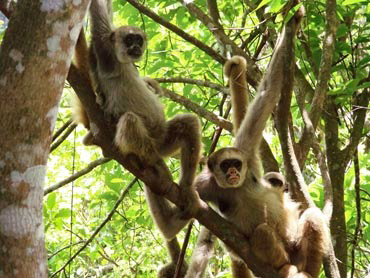 Apparent recovery of endangered muriqui monkeys in Brazil may not tell the whole story On paper, the northern muriquis (Brachyteles hypoxanthus) look like a conservation comeback story. Three decades ago, only 60 of the gentle, tree-dwelling primates lived in a fragment of the Atlantic Forest along the eastern coast of Brazil. Now there are more […]
Apparent recovery of endangered muriqui monkeys in Brazil may not tell the whole story On paper, the northern muriquis (Brachyteles hypoxanthus) look like a conservation comeback story. Three decades ago, only 60 of the gentle, tree-dwelling primates lived in a fragment of the Atlantic Forest along the eastern coast of Brazil. Now there are more […]
A new way to rescue Africa’s struggling soils: Planting perennials with crops
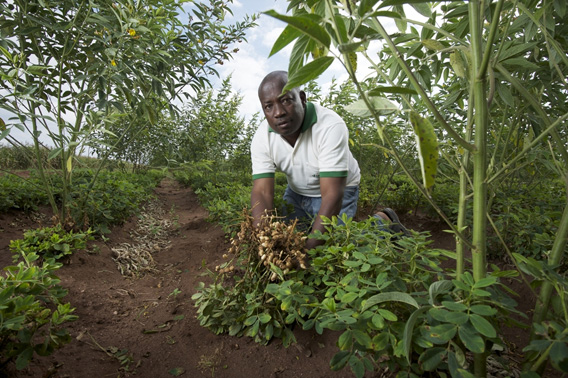 Groundnut breeder Albert Chamango grows tall perennial pigeon peas alongside his low-growing legumes to increase crop yields. Chamango works with the International Crops Research Institute for the Semi-Arid Tropics in Malawi. Photo credit: Jim Richardson. It sounds counter-intuitive: Grow more food by planting less. But it’s a plan that scientists think will produce enough crops […]
Groundnut breeder Albert Chamango grows tall perennial pigeon peas alongside his low-growing legumes to increase crop yields. Chamango works with the International Crops Research Institute for the Semi-Arid Tropics in Malawi. Photo credit: Jim Richardson. It sounds counter-intuitive: Grow more food by planting less. But it’s a plan that scientists think will produce enough crops […]
Climate change threatens population of Earth’s largest sea turtle
 A female leatherback surveys the ocean at Playa Grande, Costa Rica. While her hatchlings will be affected by rising beach temperatures, she faces threats at sea. Photo by: The Leatherback Trust. A drier, hotter climate in Central America could wipe out the population of leatherback sea turtles from the eastern Pacific Ocean by the year […]
A female leatherback surveys the ocean at Playa Grande, Costa Rica. While her hatchlings will be affected by rising beach temperatures, she faces threats at sea. Photo by: The Leatherback Trust. A drier, hotter climate in Central America could wipe out the population of leatherback sea turtles from the eastern Pacific Ocean by the year […]
Cell phones help decipher malaria transmission in Kenya
 These maps represent how people and parasites moved in this study. The red areas represent areas with more movement out of them; blue represents areas with more movement to them; yellow represents areas with equal movement in and out. The map of Kenya on the left depicts human movement, with equal travel to and from […]
These maps represent how people and parasites moved in this study. The red areas represent areas with more movement out of them; blue represents areas with more movement to them; yellow represents areas with equal movement in and out. The map of Kenya on the left depicts human movement, with equal travel to and from […]
Canadian ice sheet responded rapidly to ancient climate change
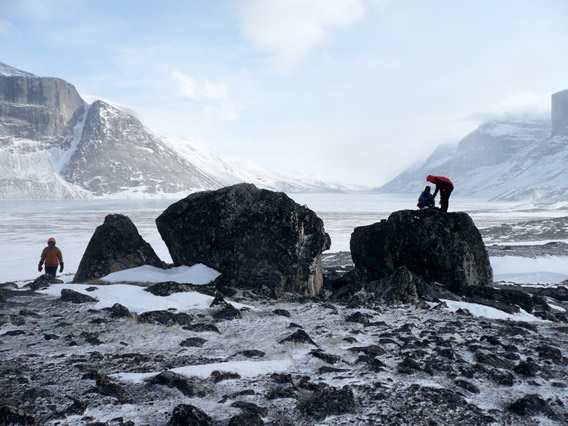 University at Buffalo students crawl over remnants of an ancient glacier on Baffin Island, Canada. Photo by Jason Briner, courtesy of the University at Buffalo. Even as glaciers retreat from rising temperatures worldwide, new research says they could bounce back just as suddenly. The study, published Sept. 14 in Science, shows that both small mountain […]
University at Buffalo students crawl over remnants of an ancient glacier on Baffin Island, Canada. Photo by Jason Briner, courtesy of the University at Buffalo. Even as glaciers retreat from rising temperatures worldwide, new research says they could bounce back just as suddenly. The study, published Sept. 14 in Science, shows that both small mountain […]
House windows may kill 22 million Canadian birds each year
 The body of a bird killed in a window strike. Birds mistake the reflective glass as a clear flight path, flying into the window at full speed. Photo by: Paige Shoemaker. The sickening thud of a bird crashing into a window is an all-too-familiar sound for many Canadian homeowners. Birds often mistake windows for openings, […]
The body of a bird killed in a window strike. Birds mistake the reflective glass as a clear flight path, flying into the window at full speed. Photo by: Paige Shoemaker. The sickening thud of a bird crashing into a window is an all-too-familiar sound for many Canadian homeowners. Birds often mistake windows for openings, […]
Clever crows may grasp hidden causes
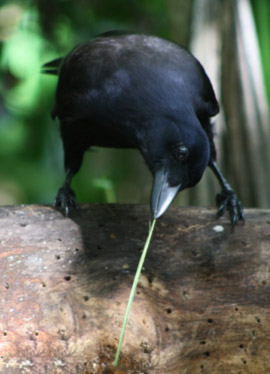 Crows may be imagining more than we imagined. New research suggests certain crows make decisions based on factors they can’t see. A recent study published in the Proceedings of the National Academy of Sciences (PNAS) deepens our understanding of these crafty corvids, and could help explain how human reasoning evolved. Crows are intelligent problem solvers, […]
Crows may be imagining more than we imagined. New research suggests certain crows make decisions based on factors they can’t see. A recent study published in the Proceedings of the National Academy of Sciences (PNAS) deepens our understanding of these crafty corvids, and could help explain how human reasoning evolved. Crows are intelligent problem solvers, […]
Antarctic king crabs warming up to invade continental shelf, threatening unique marine community
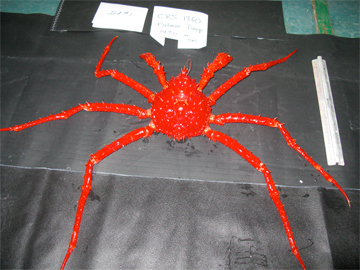 Giant crab invasion looms in Antarctica Dangerous and disruptive king crabs lurk in a deep pocket of the Antarctic continental shelf, clamoring to escape their cold-water prison to reach and permanently change the shallower, prehistoric paradise above. A team led by University of Hawaii oceanographer Craig Smith spotted the meter-long monsters in February 2010. It […]
Giant crab invasion looms in Antarctica Dangerous and disruptive king crabs lurk in a deep pocket of the Antarctic continental shelf, clamoring to escape their cold-water prison to reach and permanently change the shallower, prehistoric paradise above. A team led by University of Hawaii oceanographer Craig Smith spotted the meter-long monsters in February 2010. It […]
Entertainment media skews public perception of chimpanzees in the wild
 You’ve probably seen them: the TV ads showing chimpanzees wearing suits, driving cars, or smoking cigars. These ads may tickle our funny bone, but they warp our perceptions of how chimpanzees are faring in the wild, researchers at Duke University have found. The study, published October 12 in the journal PLoS ONE, examined whether watching […]
You’ve probably seen them: the TV ads showing chimpanzees wearing suits, driving cars, or smoking cigars. These ads may tickle our funny bone, but they warp our perceptions of how chimpanzees are faring in the wild, researchers at Duke University have found. The study, published October 12 in the journal PLoS ONE, examined whether watching […]
Tracking the coelacanth: Two decades of research confirms a viable population in Comoros
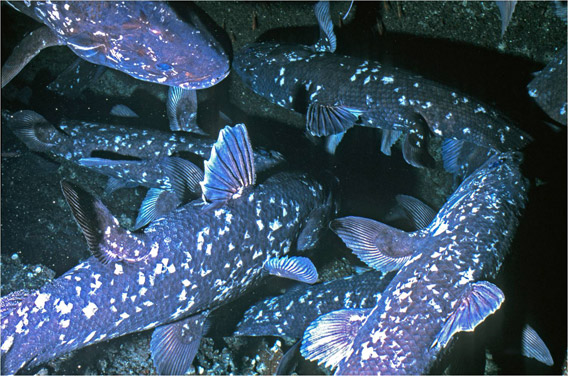 It took a custom-made submarine, billionaire Paul Allen, and a tenacious desire lasting well beyond two decades to unveil enigmatic details about the life of the coelacanth—the primitive fish that invariably hooks researchers. A study published earlier this year in the journal Marine Biology summarizes 21 years of coelacanth population research by one team, led […]
It took a custom-made submarine, billionaire Paul Allen, and a tenacious desire lasting well beyond two decades to unveil enigmatic details about the life of the coelacanth—the primitive fish that invariably hooks researchers. A study published earlier this year in the journal Marine Biology summarizes 21 years of coelacanth population research by one team, led […]
Monarch butterflies decline at wintering grounds in Mexico, Texas drought adds to stress to migration
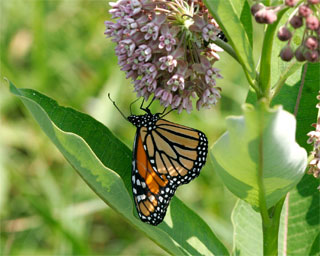 Every fall, millions of monarch butterflies travel south to Mexico and take refuge in twelve mountain sanctuaries of oyamel fir forests. Now, declining numbers of the overwintering butterflies expose the migration’s vulnerability and raise questions about threats throughout the monarch’s lifecycle. A study published online last spring in Insect Conservation and Diversity shows a decrease […]
Every fall, millions of monarch butterflies travel south to Mexico and take refuge in twelve mountain sanctuaries of oyamel fir forests. Now, declining numbers of the overwintering butterflies expose the migration’s vulnerability and raise questions about threats throughout the monarch’s lifecycle. A study published online last spring in Insect Conservation and Diversity shows a decrease […]
Indigenous technicians scour Amazonia to help researchers track wildlife populations
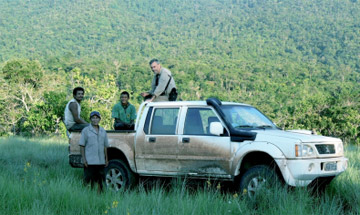 Scientists only have so many hands and eyes. That’s why ecologists enlisted hundreds of Makushi and Wapishana villagers to record the sights and signs of animals across 48,000 square kilometers of the Amazon basin near the Brazil-Guyana border. In the ongoing project, scientists seek to describe the interactions between indigenous peoples, their environment and the […]
Scientists only have so many hands and eyes. That’s why ecologists enlisted hundreds of Makushi and Wapishana villagers to record the sights and signs of animals across 48,000 square kilometers of the Amazon basin near the Brazil-Guyana border. In the ongoing project, scientists seek to describe the interactions between indigenous peoples, their environment and the […]
First global assessment finds highest-grossing tunas and billfishes most vulnerable to extinction
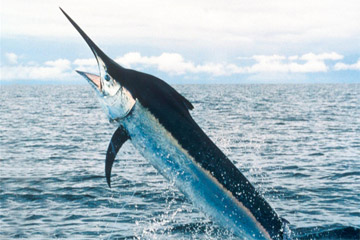 Sleek, powerful tunas and billfishes that ply the open ocean garner some of the highest prices of any fish. In January, a single bluefin tuna fetched a record $396,000 at a Tokyo auction. Yet wild fish populations pay a still higher price for such exorbitant demand: the threat of extinction. The first assessment of an […]
Sleek, powerful tunas and billfishes that ply the open ocean garner some of the highest prices of any fish. In January, a single bluefin tuna fetched a record $396,000 at a Tokyo auction. Yet wild fish populations pay a still higher price for such exorbitant demand: the threat of extinction. The first assessment of an […]
Researchers challenge idea that marine reserves promote coral recovery
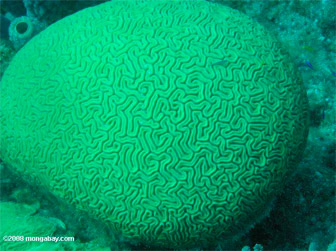 Fleshy whorls of thick brown algae blanket the once-vibrant corals in Glover’s Reef, Belize. According to a controversial study published August 14 in the journal Coral Reefs, a decade of marine reserve protection has failed to help these damaged Caribbean corals recover. Healthy reefs depend on herbivorous parrotfishes to gobble up vast algal blooms. When […]
Fleshy whorls of thick brown algae blanket the once-vibrant corals in Glover’s Reef, Belize. According to a controversial study published August 14 in the journal Coral Reefs, a decade of marine reserve protection has failed to help these damaged Caribbean corals recover. Healthy reefs depend on herbivorous parrotfishes to gobble up vast algal blooms. When […]
Small mammals use Borneo pitcher plant as toilet in exchange for nectar
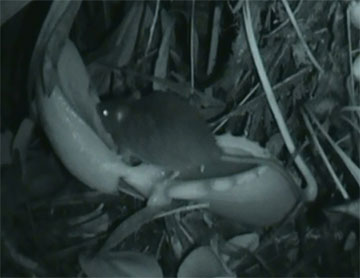 Tree shrews and nocturnal rats in the forests of Borneo have a unique relationship with carnivorous pitcher plants. The mammals defecate, and the pitchers are happy to receive. A study published on May 31 in the Journal of Tropical Ecology shows a species of giant mountain pitcher plants (Nepenthes rajah) supplements its diet with nitrogen […]
Tree shrews and nocturnal rats in the forests of Borneo have a unique relationship with carnivorous pitcher plants. The mammals defecate, and the pitchers are happy to receive. A study published on May 31 in the Journal of Tropical Ecology shows a species of giant mountain pitcher plants (Nepenthes rajah) supplements its diet with nitrogen […]
African cattle benefit from socializing with wild grazers during the wet season
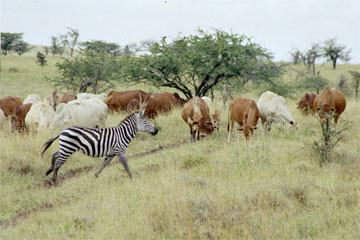 Mingling with wild grazers, such as zebra, is better for cattle than dining alone—during the wet season, at least—according to researchers in Kenya. Their new study crumbles the longstanding assumption that social grazing always leads to food fights. Kenya’s wildlife population is in a critical decline, partly due to kill-offs by ranchers who see zebra, […]
Mingling with wild grazers, such as zebra, is better for cattle than dining alone—during the wet season, at least—according to researchers in Kenya. Their new study crumbles the longstanding assumption that social grazing always leads to food fights. Kenya’s wildlife population is in a critical decline, partly due to kill-offs by ranchers who see zebra, […]
Museum specimens reveal the tracks of an amphibian epidemic
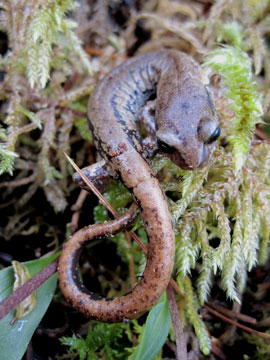 Dead men tell no tales, but dead frogs can speak volumes. Scientists have shown that frogs and salamanders preserved in museums tell the history of a deadly fungus and its spread across Mexico and Central America. The new finding, published recently in the Proceedings of the National Academy of Sciences (PNAS), may help explain past […]
Dead men tell no tales, but dead frogs can speak volumes. Scientists have shown that frogs and salamanders preserved in museums tell the history of a deadly fungus and its spread across Mexico and Central America. The new finding, published recently in the Proceedings of the National Academy of Sciences (PNAS), may help explain past […]
Bacteria deep in the Gulf of Mexico consumed oil faster than expected, study finds
 BP’s disastrous oil spill in the Gulf of Mexico this year killed countless marine animals, but it was a boon for oil-eating bacteria. The organisms, usually quiescent deep in the ocean, burst into life when the Deep Water Horizon wellhead ruptured and released a torrent of their favorite food. A study published in the 8 […]
BP’s disastrous oil spill in the Gulf of Mexico this year killed countless marine animals, but it was a boon for oil-eating bacteria. The organisms, usually quiescent deep in the ocean, burst into life when the Deep Water Horizon wellhead ruptured and released a torrent of their favorite food. A study published in the 8 […]
Cheetahs reproduce more successfully after early pregnancies
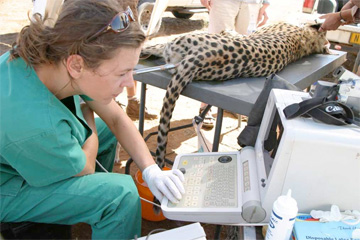 Early pregnancies prepare a cheetah for a life of productive motherhood, new research shows. A study published on 20 September in Conservation Letters advises captive breeding programs to focus on breeding female cheetahs at young ages to set the stage for many litters throughout their lives. The world’s fastest animal, the cheetah has not outpaced […]
Early pregnancies prepare a cheetah for a life of productive motherhood, new research shows. A study published on 20 September in Conservation Letters advises captive breeding programs to focus on breeding female cheetahs at young ages to set the stage for many litters throughout their lives. The world’s fastest animal, the cheetah has not outpaced […]
Ecotourism brings home the bacon in the Peruvian Amazon
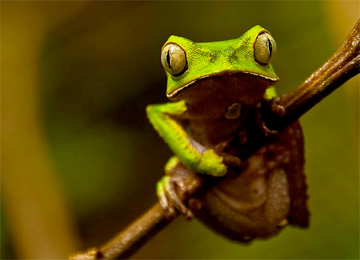 Ecotourism is one of the most profitable uses of tropical forest in the Tambopata area of the Peruvian Amazon, according to a study released on 29 September in the journal PLoS ONE. In 2002 Peru’s government passed legislation to allow ecotourism-controlled zones in the Tambopata region of southeastern Peru. Policymakers hoped such zones would preserve […]
Ecotourism is one of the most profitable uses of tropical forest in the Tambopata area of the Peruvian Amazon, according to a study released on 29 September in the journal PLoS ONE. In 2002 Peru’s government passed legislation to allow ecotourism-controlled zones in the Tambopata region of southeastern Peru. Policymakers hoped such zones would preserve […]
Rainforests, wildlife preserved by indigenous spiritual beliefs
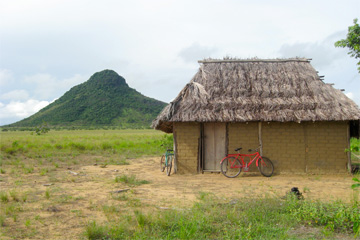 New research within the native Wapishana and Makushi communities of Guyana suggests that indigenous cultural beliefs such as shamanism help preserve tropical forests and wildlife. The analysis, published in the September 2010 Journal of Latin American Geography, draws from a massive data set that tracks wildlife populations, hunting kill sites, and spiritually significant features of […]
New research within the native Wapishana and Makushi communities of Guyana suggests that indigenous cultural beliefs such as shamanism help preserve tropical forests and wildlife. The analysis, published in the September 2010 Journal of Latin American Geography, draws from a massive data set that tracks wildlife populations, hunting kill sites, and spiritually significant features of […]
It’s not just size that matters: how population affects climate change
 As the world’s population increases, a surge in the number of older adults and the movement of people from the countryside to crowded cities will significantly affect levels of carbon dioxide emissions by 2050, according to a sweeping study published in the 11 October issue of the Proceedings of the National Academy of Sciences. A […]
As the world’s population increases, a surge in the number of older adults and the movement of people from the countryside to crowded cities will significantly affect levels of carbon dioxide emissions by 2050, according to a sweeping study published in the 11 October issue of the Proceedings of the National Academy of Sciences. A […]
Researchers track the little-known giant sunfish
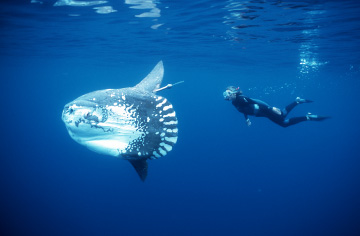 Getting to know the heaviest bony fish in the world is surprisingly hard. At 3 m (10 ft) long and 2,200 kg (4,850 lb), the Mola mola, or ocean sunfish, is an elusive giant. A typical day in its life is still a mystery. Now, a study published on 30 September in the Journal of […]
Getting to know the heaviest bony fish in the world is surprisingly hard. At 3 m (10 ft) long and 2,200 kg (4,850 lb), the Mola mola, or ocean sunfish, is an elusive giant. A typical day in its life is still a mystery. Now, a study published on 30 September in the Journal of […]
African apes threatened by rising temperatures
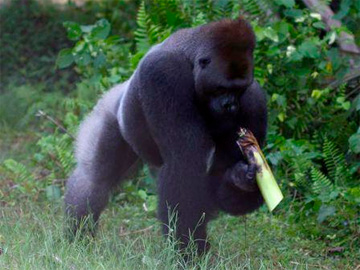 Most people wish each day had more than 24 hours. But as the planet heats up, that limited number of hours might push endangered African apes even closer to extinction by making their current habitats unsuitable for their lifestyle, according to a controversial study published on 23 July in the Journal of Biogeography. Researchers from […]
Most people wish each day had more than 24 hours. But as the planet heats up, that limited number of hours might push endangered African apes even closer to extinction by making their current habitats unsuitable for their lifestyle, according to a controversial study published on 23 July in the Journal of Biogeography. Researchers from […]
The unruly evolution of island life
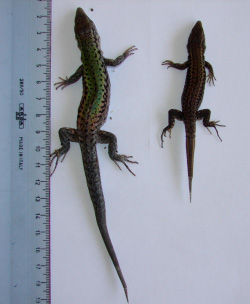 From the terrifying Komodo dragon to the diminutive hobbit Homo floresiensis, islands are home to some remarkable curiosities of size. Despite the fame of giant lizards and pygmy humans, a longstanding tenet of evolutionary biology suggests that the size of island animals moves towards the middle of the pack. A study published on 1 September […]
From the terrifying Komodo dragon to the diminutive hobbit Homo floresiensis, islands are home to some remarkable curiosities of size. Despite the fame of giant lizards and pygmy humans, a longstanding tenet of evolutionary biology suggests that the size of island animals moves towards the middle of the pack. A study published on 1 September […]
Open landfills feed population growth of predatory Alaskan gulls
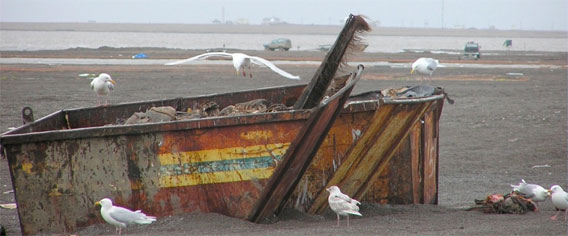 Gulls in northern Alaska are making a killing on the garbage they scavenge from landfills, new research shows. Glaucous gulls that consume a lot of trash raise more chicks than gulls that eat only natural food, according to a study in the August 2010 issue of The Condor. The garbage is a boon for the […]
Gulls in northern Alaska are making a killing on the garbage they scavenge from landfills, new research shows. Glaucous gulls that consume a lot of trash raise more chicks than gulls that eat only natural food, according to a study in the August 2010 issue of The Condor. The garbage is a boon for the […]
Growing strawberries organically yields more nutritious fruit and healthier soil
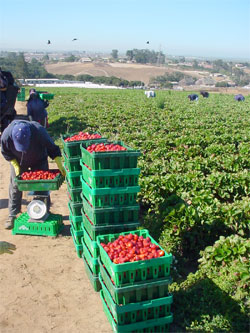 Strawberry plants grown on commercial organic farms yield higher-quality fruit and have healthier soil than those grown conventionally, according to a study published on 1 September in the journal PLoS One. The research suggests that sustainable farming practices can produce nutritious fruit, if farmers manage soil and its beneficial microbes properly. This is among the […]
Strawberry plants grown on commercial organic farms yield higher-quality fruit and have healthier soil than those grown conventionally, according to a study published on 1 September in the journal PLoS One. The research suggests that sustainable farming practices can produce nutritious fruit, if farmers manage soil and its beneficial microbes properly. This is among the […]
Japanese scientists use goldfish to screen for freshwater pollution
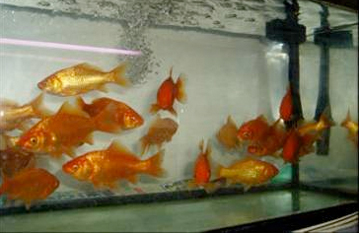 A Fate More Honorable Than Sushi
A Fate More Honorable Than Sushi
The green movement has to become a rainbow-colored movement in order to be successful
 AN INTERVIEW WITH VAN JONES AN INTERVIEW WITH VAN JONES “The green movement has to become a rainbow-colored movement in order to be successful” Maria José Viñas, special to Mongabay.com June 23, 2008 Van Jones, a social and environmental activist, believes a greener economy not only could save the planet, but also must provide pathways […]
AN INTERVIEW WITH VAN JONES AN INTERVIEW WITH VAN JONES “The green movement has to become a rainbow-colored movement in order to be successful” Maria José Viñas, special to Mongabay.com June 23, 2008 Van Jones, a social and environmental activist, believes a greener economy not only could save the planet, but also must provide pathways […]
Dried-up Colorado takes toll on giant Mexican fish
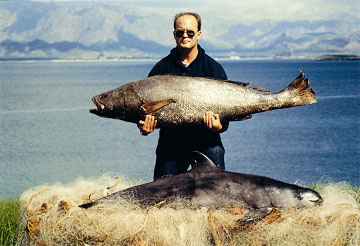 The Colorado River vanishes before it reaches the Sea of Cortez in all but the wettest years. Companies in California and the southwestern U.S. have diverted its once-vibrant flow to quench their thirst for water and power. Now, a new study in the April 2008 issue of the journal Biological Conservation reports that the dwindling […]
The Colorado River vanishes before it reaches the Sea of Cortez in all but the wettest years. Companies in California and the southwestern U.S. have diverted its once-vibrant flow to quench their thirst for water and power. Now, a new study in the April 2008 issue of the journal Biological Conservation reports that the dwindling […]
Big Farms Can Make the Leap to Organic Farming, Study Suggests
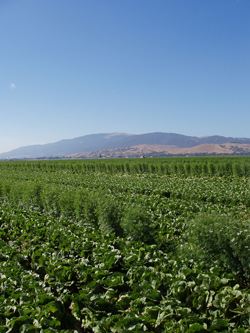 Big Farms Can Make the Leap to Organic Farming, Study Suggests Big Farms Can Make the Leap to Organic Farming, Study Suggests Erin Digitale, special to mongabay.com June 4, 2008 Large fruit and vegetable growers can adopt the methods of small-scale organic farms while maintaining crop yields, keeping pests in check, and improving the health […]
Big Farms Can Make the Leap to Organic Farming, Study Suggests Big Farms Can Make the Leap to Organic Farming, Study Suggests Erin Digitale, special to mongabay.com June 4, 2008 Large fruit and vegetable growers can adopt the methods of small-scale organic farms while maintaining crop yields, keeping pests in check, and improving the health […]
Scientists aim to catalogue tropical island from mountaintops to seafloor
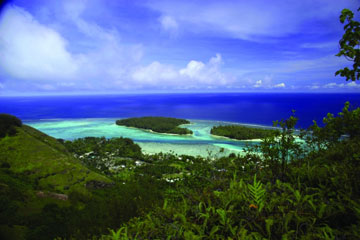 Scientists aim to catalogue tropical island from mountaintops to seafloor Scientists aim to catalogue tropical island from mountaintops to seafloor Roberta Kwok, special to mongabay.com June 4, 2008 Scientists are launching an effort to catalogue a complete tropical ecosystem, the first time anyone has attempted such an ambitious undertaking. Led by researchers at the University […]
Scientists aim to catalogue tropical island from mountaintops to seafloor Scientists aim to catalogue tropical island from mountaintops to seafloor Roberta Kwok, special to mongabay.com June 4, 2008 Scientists are launching an effort to catalogue a complete tropical ecosystem, the first time anyone has attempted such an ambitious undertaking. Led by researchers at the University […]
Diversity in streams may brace Chinook salmon for climate change
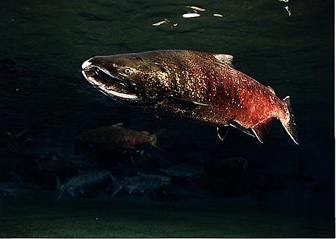 Diversity in streams may brace Chinook salmon for climate change Diversity in streams may brace Chinook salmon for climate change Hayley Rutger, special to mongabay.com June 3, 2008 Chinook salmon face a one-two punch. They have disappeared from several rivers in the western U.S. largely because of human interventions and some populations are threatened or […]
Diversity in streams may brace Chinook salmon for climate change Diversity in streams may brace Chinook salmon for climate change Hayley Rutger, special to mongabay.com June 3, 2008 Chinook salmon face a one-two punch. They have disappeared from several rivers in the western U.S. largely because of human interventions and some populations are threatened or […]
Food miles are less important to environment than food choices, study concludes
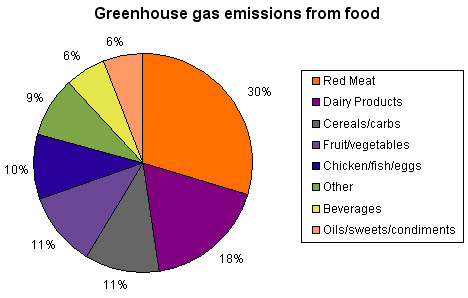 Food miles are less important to environment than food choices, study concludes Food miles are less important to environment than food choices, study concludes Jane Liaw, special to mongabay.com June 2, 2008 Shoppers concerned about the environment should not place “buying local” at the top of their list of priorities when purchasing food, according to […]
Food miles are less important to environment than food choices, study concludes Food miles are less important to environment than food choices, study concludes Jane Liaw, special to mongabay.com June 2, 2008 Shoppers concerned about the environment should not place “buying local” at the top of their list of priorities when purchasing food, according to […]
Cellulosic biofuels may be viable alternative to gas within 5 years
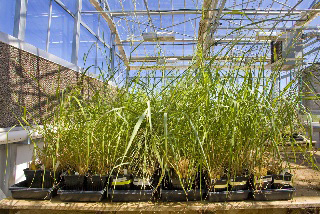 Cellulosic biofuels may be viable alternative to gas within 5 years High fuel prices to make cellulosic biofuels increasingly competitive with gas Madolyn Rogers, special to mongabay.com June 2, 2008 A new institute in the San Francisco Bay Area is seeking to make cellulosic biofuel an economically viable alternative to corn ethanol and gasoline within […]
Cellulosic biofuels may be viable alternative to gas within 5 years High fuel prices to make cellulosic biofuels increasingly competitive with gas Madolyn Rogers, special to mongabay.com June 2, 2008 A new institute in the San Francisco Bay Area is seeking to make cellulosic biofuel an economically viable alternative to corn ethanol and gasoline within […]
High-tech collars to reveal the secretive behvaiors of mountain lions
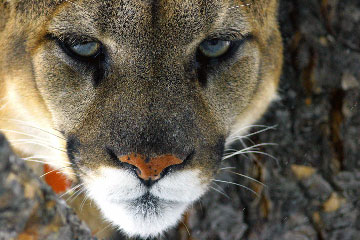 High-tech collars to reveal the secretive behaviors of mountain lions High-tech collars to reveal the secretive behaviors of mountain lions María José Viñas, special to mongabay.com May 28, 2008 A handful of mountain lions in the Santa Cruz Mountains of California soon will wear high-tech collars as part of a new study by researchers at […]
High-tech collars to reveal the secretive behaviors of mountain lions High-tech collars to reveal the secretive behaviors of mountain lions María José Viñas, special to mongabay.com May 28, 2008 A handful of mountain lions in the Santa Cruz Mountains of California soon will wear high-tech collars as part of a new study by researchers at […]
50 years after the blast: Recovery in Bikini Atoll’s coral reef
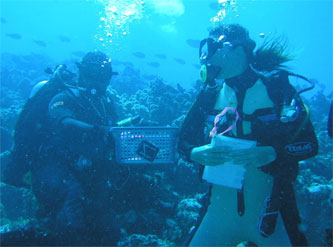 50 years after the blast: Recovery in Bikini Atoll’s coral reef 50 years after the blast: Recovery in Bikini Atoll’s coral reef Amber Dance, special to mongabay.com May 27, 2008 Fifty years after atomic bombs rocked Bikini Atoll and pulverized its coral reef, the lagoon again boasts a flourishing coral community. Scientists diving in the […]
50 years after the blast: Recovery in Bikini Atoll’s coral reef 50 years after the blast: Recovery in Bikini Atoll’s coral reef Amber Dance, special to mongabay.com May 27, 2008 Fifty years after atomic bombs rocked Bikini Atoll and pulverized its coral reef, the lagoon again boasts a flourishing coral community. Scientists diving in the […]
From “kampung boy” to conservation force in the rainforest of Borneo
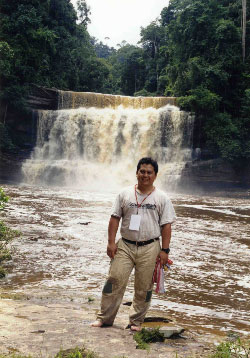 From “kampung boy” conservation force in the rainforest of Borneo From “kampung boy” to conservation force in the Malaysian rainforest Alissa Poh, special to mongabay.com May 27, 2008 Waidi Sinun oversees three extraordinarily diverse conservation areas in the Malaysian rainforest, a career shaped by a love for the environment stemming from childhood memories, as well […]
From “kampung boy” conservation force in the rainforest of Borneo From “kampung boy” to conservation force in the Malaysian rainforest Alissa Poh, special to mongabay.com May 27, 2008 Waidi Sinun oversees three extraordinarily diverse conservation areas in the Malaysian rainforest, a career shaped by a love for the environment stemming from childhood memories, as well […]
Why is there soot on the snowpack?
 Do pollutants from Asia affect California’s climate? Why is there soot on the snowpack? New air sampling stations in Sierra Nevada will search for pollution sources Massie Santos Ballon, special to mongabay.com May 22, 2008 This fall, suitcase-sized air samplers will sprout throughout the Sierra Nevada. The air monitoring stations will be installed by researchers […]
Do pollutants from Asia affect California’s climate? Why is there soot on the snowpack? New air sampling stations in Sierra Nevada will search for pollution sources Massie Santos Ballon, special to mongabay.com May 22, 2008 This fall, suitcase-sized air samplers will sprout throughout the Sierra Nevada. The air monitoring stations will be installed by researchers […]
Feeds: news | india | latam | brasil | indonesia
 Planting trees may be a cost-effective way to reduce ground-level ozone, a toxic component of smog that contributes to the deaths of about 152,000 people annually worldwide, according to new research. The study is the first to lay out a practical plan and examine the economic impacts of lowering ozone levels with trees. Scientists used […]
Planting trees may be a cost-effective way to reduce ground-level ozone, a toxic component of smog that contributes to the deaths of about 152,000 people annually worldwide, according to new research. The study is the first to lay out a practical plan and examine the economic impacts of lowering ozone levels with trees. Scientists used […] While unpleasant car exhaust makes us wrinkle our noses, such human-made fumes may pose serious problems to insects searching for nectar. Researchers recently revealed that background odors make finding flowers difficult for pollinators. The study, published in Science, measured how hawk moths (Manduca sexta) pick out the sacred datura flower scent (Datura wrightii) amidst all […]
While unpleasant car exhaust makes us wrinkle our noses, such human-made fumes may pose serious problems to insects searching for nectar. Researchers recently revealed that background odors make finding flowers difficult for pollinators. The study, published in Science, measured how hawk moths (Manduca sexta) pick out the sacred datura flower scent (Datura wrightii) amidst all […] It all went to hell when Jane Goodall started handing out bananas. Within a few years, the previously peaceful chimpanzees she was studying split into two warring tribes. Gangs of males from the larger faction systematically slaughtered their former tribemates. All over the bananas. Or so the argument goes. The idea that feeding the chimps […]
It all went to hell when Jane Goodall started handing out bananas. Within a few years, the previously peaceful chimpanzees she was studying split into two warring tribes. Gangs of males from the larger faction systematically slaughtered their former tribemates. All over the bananas. Or so the argument goes. The idea that feeding the chimps […] Reduced river flows below irrigation dams decimate freshwater dolphins Rare photo showing two Indus River dolphins in the wild. Photo credit: Albert Reichert, CC-BY.N The Indus River dolphin (Platanista gangetica minor) is an endangered freshwater mammal found only in the Indus River and tributaries draining the Himalayas. Since 1879, the dolphin—locally known as the bhulan—has […]
Reduced river flows below irrigation dams decimate freshwater dolphins Rare photo showing two Indus River dolphins in the wild. Photo credit: Albert Reichert, CC-BY.N The Indus River dolphin (Platanista gangetica minor) is an endangered freshwater mammal found only in the Indus River and tributaries draining the Himalayas. Since 1879, the dolphin—locally known as the bhulan—has […] Miniature acoustic tags allow researchers to track newborn sea turtles during ‘swimming frenzy’ Baby sea turtles vanish after they scamper into the ocean. Years later, juvenile turtles may pop up thousands of kilometers away, but often scientists don’t see them again until they return to their birthplaces to nest on the beach. Now, using tiny […]
Miniature acoustic tags allow researchers to track newborn sea turtles during ‘swimming frenzy’ Baby sea turtles vanish after they scamper into the ocean. Years later, juvenile turtles may pop up thousands of kilometers away, but often scientists don’t see them again until they return to their birthplaces to nest on the beach. Now, using tiny […] Researchers find that warming ocean and acidification could hit young sharks hard Fierce predatory sharks rule the oceans from the apex of the food pyramid. But climate change may be tougher than these marine hunters, a new study suggests. As oceans warm and their waters become more acidic, fewer sharks may survive their infancies. No […]
Researchers find that warming ocean and acidification could hit young sharks hard Fierce predatory sharks rule the oceans from the apex of the food pyramid. But climate change may be tougher than these marine hunters, a new study suggests. As oceans warm and their waters become more acidic, fewer sharks may survive their infancies. No […] Little chance of reaching ‘sustainable population’ in next century According to recent projections, the number of people living on Earth could exceed ten billion by the end of this century. Now, a new study has examined what it would take to reverse that unrelenting growth and achieve a sustainable population that is less threatening to […]
Little chance of reaching ‘sustainable population’ in next century According to recent projections, the number of people living on Earth could exceed ten billion by the end of this century. Now, a new study has examined what it would take to reverse that unrelenting growth and achieve a sustainable population that is less threatening to […] What happened to Egypt’s Serengeti-like ecosystem? Art helps scientists unravel the past The scientists found that major disappearances coincided with climate and environmental changes. Click here to see a Brazilian interactive graphic of the extinctions. Graphic by: William Mariotto and Vinicius Sueiro, Estadao. Life in modern Egypt clings to the Nile River. This crowded green […]
What happened to Egypt’s Serengeti-like ecosystem? Art helps scientists unravel the past The scientists found that major disappearances coincided with climate and environmental changes. Click here to see a Brazilian interactive graphic of the extinctions. Graphic by: William Mariotto and Vinicius Sueiro, Estadao. Life in modern Egypt clings to the Nile River. This crowded green […] A controlled burning of Macondo well oil from the Deepwater Horizon disaster that rose to the ocean surface. [Credit: David Valentine] Images from the 2010 Deepwater Horizon disaster endure, from the collapsing platform to oil-fouled coastline. But beneath the surface is a story photographers cannot as easily capture. Two days after the April 20, 2010 […]
A controlled burning of Macondo well oil from the Deepwater Horizon disaster that rose to the ocean surface. [Credit: David Valentine] Images from the 2010 Deepwater Horizon disaster endure, from the collapsing platform to oil-fouled coastline. But beneath the surface is a story photographers cannot as easily capture. Two days after the April 20, 2010 […] A small-scale fisher in Sri Lanka. [Credit: Nishan Perreira/Project Seahorse]. Do you know how that tuna sashimi got to your dinner plate? Probably not—and chances are, the restaurant that served it to you doesn’t know, either. A new policy paper argues that illicit fishing practices are flying under the radar all around the world, and […]
A small-scale fisher in Sri Lanka. [Credit: Nishan Perreira/Project Seahorse]. Do you know how that tuna sashimi got to your dinner plate? Probably not—and chances are, the restaurant that served it to you doesn’t know, either. A new policy paper argues that illicit fishing practices are flying under the radar all around the world, and […] Millions drink toxic arsenic in their water. This German nature lover and microbiologist says bioluminescent bacteria could light the path to safety. Interview by Nsikan Akpan. A knob turns, and pure water streams from the faucet. In developed nations, this expectation borders on being a fundamental human right. Elsewhere in the world, tap water is […]
Millions drink toxic arsenic in their water. This German nature lover and microbiologist says bioluminescent bacteria could light the path to safety. Interview by Nsikan Akpan. A knob turns, and pure water streams from the faucet. In developed nations, this expectation borders on being a fundamental human right. Elsewhere in the world, tap water is […] The catastrophic explosion that spewed some five million barrels of oil deep into the Gulf of Mexico in April 2010 will take a heavy toll in the ocean’s lowest layers for years to come. That’s the stark conclusion of seafloor research conducted six months after the Deepwater Horizon oil spill. The study, published on August […]
The catastrophic explosion that spewed some five million barrels of oil deep into the Gulf of Mexico in April 2010 will take a heavy toll in the ocean’s lowest layers for years to come. That’s the stark conclusion of seafloor research conducted six months after the Deepwater Horizon oil spill. The study, published on August […] At first glance, a recent report from the U.S. White House on the social cost of carbon reads like a daunting economics exam. A small chart poses the first question about the price tag policymakers attach to future greenhouse gas emissions: Does each metric ton of carbon that billows into the air cost $11, $33 […]
At first glance, a recent report from the U.S. White House on the social cost of carbon reads like a daunting economics exam. A small chart poses the first question about the price tag policymakers attach to future greenhouse gas emissions: Does each metric ton of carbon that billows into the air cost $11, $33 […] A polar bear plods through summer mud in the Hudson Bay Lowlands. Photo by: Jon Sweetman. The mighty polar bear has long been the poster child for the effects of global warming in the Arctic, but the microscopic diatom tells an equally powerful story. Diatoms are a type of algae that form the base of […]
A polar bear plods through summer mud in the Hudson Bay Lowlands. Photo by: Jon Sweetman. The mighty polar bear has long been the poster child for the effects of global warming in the Arctic, but the microscopic diatom tells an equally powerful story. Diatoms are a type of algae that form the base of […] They evaded humans for millions of years and live very private lives. The hulking, fleshy-finned fish known as the coelacanth has beguiled scientists for generations. But the coelacanth mystique that enchants researchers also makes it difficult to study. Researchers recently revealed in Nature Communications one startling aspect of the coelacanth lifestyle: they might be monogamous. […]
They evaded humans for millions of years and live very private lives. The hulking, fleshy-finned fish known as the coelacanth has beguiled scientists for generations. But the coelacanth mystique that enchants researchers also makes it difficult to study. Researchers recently revealed in Nature Communications one startling aspect of the coelacanth lifestyle: they might be monogamous. […] Hundreds of kilometers of commercial fishing lines slither along coastal waters in Costa Rica, hooking thousands of mahi-mahi and many other marketable fish. But when scientists scrutinized fishermen’s catch, they were shocked by the staggering number of sea turtles accidentally snagged on the lines. A study published Aug. 20 in the Journal of Experimental Marine […]
Hundreds of kilometers of commercial fishing lines slither along coastal waters in Costa Rica, hooking thousands of mahi-mahi and many other marketable fish. But when scientists scrutinized fishermen’s catch, they were shocked by the staggering number of sea turtles accidentally snagged on the lines. A study published Aug. 20 in the Journal of Experimental Marine […] Wolves and grizzlies aren’t best buddies. Burly bears can barge in on a feasting pack, making off with the wolves’ fresh kill. Wolves have been known to dig into bear dens and snag a cub. But after gray wolves returned to Yellowstone National Park in 1995, grizzly bears ate more berries in the summer for […]
Wolves and grizzlies aren’t best buddies. Burly bears can barge in on a feasting pack, making off with the wolves’ fresh kill. Wolves have been known to dig into bear dens and snag a cub. But after gray wolves returned to Yellowstone National Park in 1995, grizzly bears ate more berries in the summer for […] The plan from Ecuador’s government was simple: Pay us and we won’t destroy the planet’s most extraordinary ecosystem. Dubbed the Yasuní-ITT initiative, the plan called upon developed nations to pay for protecting Ecuador’s Yasuní National Park from oil companies. Now, a recent study claims the plan was fraught with flaws as basic as drawing lines […]
The plan from Ecuador’s government was simple: Pay us and we won’t destroy the planet’s most extraordinary ecosystem. Dubbed the Yasuní-ITT initiative, the plan called upon developed nations to pay for protecting Ecuador’s Yasuní National Park from oil companies. Now, a recent study claims the plan was fraught with flaws as basic as drawing lines […] Some good news out of the Amazon rainforest: given enough time, deforested land can rebound enough to host bird species that had previously deserted the area, according to a recent study in The Auk. Between 1992 and 2011, a team led by Philip Stouffer of Louisiana State University tracked the movements of birds through fragmented […]
Some good news out of the Amazon rainforest: given enough time, deforested land can rebound enough to host bird species that had previously deserted the area, according to a recent study in The Auk. Between 1992 and 2011, a team led by Philip Stouffer of Louisiana State University tracked the movements of birds through fragmented […] The Amazon rainforest is so vast, and so diverse, that seemingly simple questions— such as which species of trees are most common— remain unanswered. Researchers are finally seeing the forest and the trees after an international collaboration of 120 scientists teamed up to compile the largest tree survey ever assembled from the Amazon. The report, […]
The Amazon rainforest is so vast, and so diverse, that seemingly simple questions— such as which species of trees are most common— remain unanswered. Researchers are finally seeing the forest and the trees after an international collaboration of 120 scientists teamed up to compile the largest tree survey ever assembled from the Amazon. The report, […] Puppet shows, posters and children’s activities that draw from local traditions are helping to save an endangered monkey in China. The activities, which encourage villagers—children and adults alike—to protect their forests and adopt fuel-efficient cooking stoves, have worked, according to a report published in Conservation Evidence. Local Chinese researchers, supported by the U.S.-based conservation organization […]
Puppet shows, posters and children’s activities that draw from local traditions are helping to save an endangered monkey in China. The activities, which encourage villagers—children and adults alike—to protect their forests and adopt fuel-efficient cooking stoves, have worked, according to a report published in Conservation Evidence. Local Chinese researchers, supported by the U.S.-based conservation organization […] In 1990, British cloud physicist John Latham published a paper arguing he could cool global climate by brightening clouds over the ocean. Most colleagues ignored the paper, titled “Control global warming?”—probably because this thing called global warming was not yet a hot topic. Now, more than two decades later, Latham continues to develop what has […]
In 1990, British cloud physicist John Latham published a paper arguing he could cool global climate by brightening clouds over the ocean. Most colleagues ignored the paper, titled “Control global warming?”—probably because this thing called global warming was not yet a hot topic. Now, more than two decades later, Latham continues to develop what has […] Indonesian fishermen load sardines into the back of a truck. Photo by Rhett Butler. Global fisheries are gutting the world economy by US$13 billion annually, according to an economic analysis published July 13 in the journal PLoS ONE. National subsidies that encourage overfishing cause the most losses, the analysis claims. However, researchers believe that allowing […]
Indonesian fishermen load sardines into the back of a truck. Photo by Rhett Butler. Global fisheries are gutting the world economy by US$13 billion annually, according to an economic analysis published July 13 in the journal PLoS ONE. National subsidies that encourage overfishing cause the most losses, the analysis claims. However, researchers believe that allowing […] Apparent recovery of endangered muriqui monkeys in Brazil may not tell the whole story On paper, the northern muriquis (Brachyteles hypoxanthus) look like a conservation comeback story. Three decades ago, only 60 of the gentle, tree-dwelling primates lived in a fragment of the Atlantic Forest along the eastern coast of Brazil. Now there are more […]
Apparent recovery of endangered muriqui monkeys in Brazil may not tell the whole story On paper, the northern muriquis (Brachyteles hypoxanthus) look like a conservation comeback story. Three decades ago, only 60 of the gentle, tree-dwelling primates lived in a fragment of the Atlantic Forest along the eastern coast of Brazil. Now there are more […] Groundnut breeder Albert Chamango grows tall perennial pigeon peas alongside his low-growing legumes to increase crop yields. Chamango works with the International Crops Research Institute for the Semi-Arid Tropics in Malawi. Photo credit: Jim Richardson. It sounds counter-intuitive: Grow more food by planting less. But it’s a plan that scientists think will produce enough crops […]
Groundnut breeder Albert Chamango grows tall perennial pigeon peas alongside his low-growing legumes to increase crop yields. Chamango works with the International Crops Research Institute for the Semi-Arid Tropics in Malawi. Photo credit: Jim Richardson. It sounds counter-intuitive: Grow more food by planting less. But it’s a plan that scientists think will produce enough crops […] A female leatherback surveys the ocean at Playa Grande, Costa Rica. While her hatchlings will be affected by rising beach temperatures, she faces threats at sea. Photo by: The Leatherback Trust. A drier, hotter climate in Central America could wipe out the population of leatherback sea turtles from the eastern Pacific Ocean by the year […]
A female leatherback surveys the ocean at Playa Grande, Costa Rica. While her hatchlings will be affected by rising beach temperatures, she faces threats at sea. Photo by: The Leatherback Trust. A drier, hotter climate in Central America could wipe out the population of leatherback sea turtles from the eastern Pacific Ocean by the year […] These maps represent how people and parasites moved in this study. The red areas represent areas with more movement out of them; blue represents areas with more movement to them; yellow represents areas with equal movement in and out. The map of Kenya on the left depicts human movement, with equal travel to and from […]
These maps represent how people and parasites moved in this study. The red areas represent areas with more movement out of them; blue represents areas with more movement to them; yellow represents areas with equal movement in and out. The map of Kenya on the left depicts human movement, with equal travel to and from […] University at Buffalo students crawl over remnants of an ancient glacier on Baffin Island, Canada. Photo by Jason Briner, courtesy of the University at Buffalo. Even as glaciers retreat from rising temperatures worldwide, new research says they could bounce back just as suddenly. The study, published Sept. 14 in Science, shows that both small mountain […]
University at Buffalo students crawl over remnants of an ancient glacier on Baffin Island, Canada. Photo by Jason Briner, courtesy of the University at Buffalo. Even as glaciers retreat from rising temperatures worldwide, new research says they could bounce back just as suddenly. The study, published Sept. 14 in Science, shows that both small mountain […] The body of a bird killed in a window strike. Birds mistake the reflective glass as a clear flight path, flying into the window at full speed. Photo by: Paige Shoemaker. The sickening thud of a bird crashing into a window is an all-too-familiar sound for many Canadian homeowners. Birds often mistake windows for openings, […]
The body of a bird killed in a window strike. Birds mistake the reflective glass as a clear flight path, flying into the window at full speed. Photo by: Paige Shoemaker. The sickening thud of a bird crashing into a window is an all-too-familiar sound for many Canadian homeowners. Birds often mistake windows for openings, […] Crows may be imagining more than we imagined. New research suggests certain crows make decisions based on factors they can’t see. A recent study published in the Proceedings of the National Academy of Sciences (PNAS) deepens our understanding of these crafty corvids, and could help explain how human reasoning evolved. Crows are intelligent problem solvers, […]
Crows may be imagining more than we imagined. New research suggests certain crows make decisions based on factors they can’t see. A recent study published in the Proceedings of the National Academy of Sciences (PNAS) deepens our understanding of these crafty corvids, and could help explain how human reasoning evolved. Crows are intelligent problem solvers, […] Giant crab invasion looms in Antarctica Dangerous and disruptive king crabs lurk in a deep pocket of the Antarctic continental shelf, clamoring to escape their cold-water prison to reach and permanently change the shallower, prehistoric paradise above. A team led by University of Hawaii oceanographer Craig Smith spotted the meter-long monsters in February 2010. It […]
Giant crab invasion looms in Antarctica Dangerous and disruptive king crabs lurk in a deep pocket of the Antarctic continental shelf, clamoring to escape their cold-water prison to reach and permanently change the shallower, prehistoric paradise above. A team led by University of Hawaii oceanographer Craig Smith spotted the meter-long monsters in February 2010. It […] You’ve probably seen them: the TV ads showing chimpanzees wearing suits, driving cars, or smoking cigars. These ads may tickle our funny bone, but they warp our perceptions of how chimpanzees are faring in the wild, researchers at Duke University have found. The study, published October 12 in the journal PLoS ONE, examined whether watching […]
You’ve probably seen them: the TV ads showing chimpanzees wearing suits, driving cars, or smoking cigars. These ads may tickle our funny bone, but they warp our perceptions of how chimpanzees are faring in the wild, researchers at Duke University have found. The study, published October 12 in the journal PLoS ONE, examined whether watching […] It took a custom-made submarine, billionaire Paul Allen, and a tenacious desire lasting well beyond two decades to unveil enigmatic details about the life of the coelacanth—the primitive fish that invariably hooks researchers. A study published earlier this year in the journal Marine Biology summarizes 21 years of coelacanth population research by one team, led […]
It took a custom-made submarine, billionaire Paul Allen, and a tenacious desire lasting well beyond two decades to unveil enigmatic details about the life of the coelacanth—the primitive fish that invariably hooks researchers. A study published earlier this year in the journal Marine Biology summarizes 21 years of coelacanth population research by one team, led […] Every fall, millions of monarch butterflies travel south to Mexico and take refuge in twelve mountain sanctuaries of oyamel fir forests. Now, declining numbers of the overwintering butterflies expose the migration’s vulnerability and raise questions about threats throughout the monarch’s lifecycle. A study published online last spring in Insect Conservation and Diversity shows a decrease […]
Every fall, millions of monarch butterflies travel south to Mexico and take refuge in twelve mountain sanctuaries of oyamel fir forests. Now, declining numbers of the overwintering butterflies expose the migration’s vulnerability and raise questions about threats throughout the monarch’s lifecycle. A study published online last spring in Insect Conservation and Diversity shows a decrease […] Scientists only have so many hands and eyes. That’s why ecologists enlisted hundreds of Makushi and Wapishana villagers to record the sights and signs of animals across 48,000 square kilometers of the Amazon basin near the Brazil-Guyana border. In the ongoing project, scientists seek to describe the interactions between indigenous peoples, their environment and the […]
Scientists only have so many hands and eyes. That’s why ecologists enlisted hundreds of Makushi and Wapishana villagers to record the sights and signs of animals across 48,000 square kilometers of the Amazon basin near the Brazil-Guyana border. In the ongoing project, scientists seek to describe the interactions between indigenous peoples, their environment and the […] Sleek, powerful tunas and billfishes that ply the open ocean garner some of the highest prices of any fish. In January, a single bluefin tuna fetched a record $396,000 at a Tokyo auction. Yet wild fish populations pay a still higher price for such exorbitant demand: the threat of extinction. The first assessment of an […]
Sleek, powerful tunas and billfishes that ply the open ocean garner some of the highest prices of any fish. In January, a single bluefin tuna fetched a record $396,000 at a Tokyo auction. Yet wild fish populations pay a still higher price for such exorbitant demand: the threat of extinction. The first assessment of an […] Fleshy whorls of thick brown algae blanket the once-vibrant corals in Glover’s Reef, Belize. According to a controversial study published August 14 in the journal Coral Reefs, a decade of marine reserve protection has failed to help these damaged Caribbean corals recover. Healthy reefs depend on herbivorous parrotfishes to gobble up vast algal blooms. When […]
Fleshy whorls of thick brown algae blanket the once-vibrant corals in Glover’s Reef, Belize. According to a controversial study published August 14 in the journal Coral Reefs, a decade of marine reserve protection has failed to help these damaged Caribbean corals recover. Healthy reefs depend on herbivorous parrotfishes to gobble up vast algal blooms. When […] Tree shrews and nocturnal rats in the forests of Borneo have a unique relationship with carnivorous pitcher plants. The mammals defecate, and the pitchers are happy to receive. A study published on May 31 in the Journal of Tropical Ecology shows a species of giant mountain pitcher plants (Nepenthes rajah) supplements its diet with nitrogen […]
Tree shrews and nocturnal rats in the forests of Borneo have a unique relationship with carnivorous pitcher plants. The mammals defecate, and the pitchers are happy to receive. A study published on May 31 in the Journal of Tropical Ecology shows a species of giant mountain pitcher plants (Nepenthes rajah) supplements its diet with nitrogen […] Mingling with wild grazers, such as zebra, is better for cattle than dining alone—during the wet season, at least—according to researchers in Kenya. Their new study crumbles the longstanding assumption that social grazing always leads to food fights. Kenya’s wildlife population is in a critical decline, partly due to kill-offs by ranchers who see zebra, […]
Mingling with wild grazers, such as zebra, is better for cattle than dining alone—during the wet season, at least—according to researchers in Kenya. Their new study crumbles the longstanding assumption that social grazing always leads to food fights. Kenya’s wildlife population is in a critical decline, partly due to kill-offs by ranchers who see zebra, […] Dead men tell no tales, but dead frogs can speak volumes. Scientists have shown that frogs and salamanders preserved in museums tell the history of a deadly fungus and its spread across Mexico and Central America. The new finding, published recently in the Proceedings of the National Academy of Sciences (PNAS), may help explain past […]
Dead men tell no tales, but dead frogs can speak volumes. Scientists have shown that frogs and salamanders preserved in museums tell the history of a deadly fungus and its spread across Mexico and Central America. The new finding, published recently in the Proceedings of the National Academy of Sciences (PNAS), may help explain past […] BP’s disastrous oil spill in the Gulf of Mexico this year killed countless marine animals, but it was a boon for oil-eating bacteria. The organisms, usually quiescent deep in the ocean, burst into life when the Deep Water Horizon wellhead ruptured and released a torrent of their favorite food. A study published in the 8 […]
BP’s disastrous oil spill in the Gulf of Mexico this year killed countless marine animals, but it was a boon for oil-eating bacteria. The organisms, usually quiescent deep in the ocean, burst into life when the Deep Water Horizon wellhead ruptured and released a torrent of their favorite food. A study published in the 8 […] Early pregnancies prepare a cheetah for a life of productive motherhood, new research shows. A study published on 20 September in Conservation Letters advises captive breeding programs to focus on breeding female cheetahs at young ages to set the stage for many litters throughout their lives. The world’s fastest animal, the cheetah has not outpaced […]
Early pregnancies prepare a cheetah for a life of productive motherhood, new research shows. A study published on 20 September in Conservation Letters advises captive breeding programs to focus on breeding female cheetahs at young ages to set the stage for many litters throughout their lives. The world’s fastest animal, the cheetah has not outpaced […] Ecotourism is one of the most profitable uses of tropical forest in the Tambopata area of the Peruvian Amazon, according to a study released on 29 September in the journal PLoS ONE. In 2002 Peru’s government passed legislation to allow ecotourism-controlled zones in the Tambopata region of southeastern Peru. Policymakers hoped such zones would preserve […]
Ecotourism is one of the most profitable uses of tropical forest in the Tambopata area of the Peruvian Amazon, according to a study released on 29 September in the journal PLoS ONE. In 2002 Peru’s government passed legislation to allow ecotourism-controlled zones in the Tambopata region of southeastern Peru. Policymakers hoped such zones would preserve […] New research within the native Wapishana and Makushi communities of Guyana suggests that indigenous cultural beliefs such as shamanism help preserve tropical forests and wildlife. The analysis, published in the September 2010 Journal of Latin American Geography, draws from a massive data set that tracks wildlife populations, hunting kill sites, and spiritually significant features of […]
New research within the native Wapishana and Makushi communities of Guyana suggests that indigenous cultural beliefs such as shamanism help preserve tropical forests and wildlife. The analysis, published in the September 2010 Journal of Latin American Geography, draws from a massive data set that tracks wildlife populations, hunting kill sites, and spiritually significant features of […] As the world’s population increases, a surge in the number of older adults and the movement of people from the countryside to crowded cities will significantly affect levels of carbon dioxide emissions by 2050, according to a sweeping study published in the 11 October issue of the Proceedings of the National Academy of Sciences. A […]
As the world’s population increases, a surge in the number of older adults and the movement of people from the countryside to crowded cities will significantly affect levels of carbon dioxide emissions by 2050, according to a sweeping study published in the 11 October issue of the Proceedings of the National Academy of Sciences. A […] Getting to know the heaviest bony fish in the world is surprisingly hard. At 3 m (10 ft) long and 2,200 kg (4,850 lb), the Mola mola, or ocean sunfish, is an elusive giant. A typical day in its life is still a mystery. Now, a study published on 30 September in the Journal of […]
Getting to know the heaviest bony fish in the world is surprisingly hard. At 3 m (10 ft) long and 2,200 kg (4,850 lb), the Mola mola, or ocean sunfish, is an elusive giant. A typical day in its life is still a mystery. Now, a study published on 30 September in the Journal of […] Most people wish each day had more than 24 hours. But as the planet heats up, that limited number of hours might push endangered African apes even closer to extinction by making their current habitats unsuitable for their lifestyle, according to a controversial study published on 23 July in the Journal of Biogeography. Researchers from […]
Most people wish each day had more than 24 hours. But as the planet heats up, that limited number of hours might push endangered African apes even closer to extinction by making their current habitats unsuitable for their lifestyle, according to a controversial study published on 23 July in the Journal of Biogeography. Researchers from […] From the terrifying Komodo dragon to the diminutive hobbit Homo floresiensis, islands are home to some remarkable curiosities of size. Despite the fame of giant lizards and pygmy humans, a longstanding tenet of evolutionary biology suggests that the size of island animals moves towards the middle of the pack. A study published on 1 September […]
From the terrifying Komodo dragon to the diminutive hobbit Homo floresiensis, islands are home to some remarkable curiosities of size. Despite the fame of giant lizards and pygmy humans, a longstanding tenet of evolutionary biology suggests that the size of island animals moves towards the middle of the pack. A study published on 1 September […] Gulls in northern Alaska are making a killing on the garbage they scavenge from landfills, new research shows. Glaucous gulls that consume a lot of trash raise more chicks than gulls that eat only natural food, according to a study in the August 2010 issue of The Condor. The garbage is a boon for the […]
Gulls in northern Alaska are making a killing on the garbage they scavenge from landfills, new research shows. Glaucous gulls that consume a lot of trash raise more chicks than gulls that eat only natural food, according to a study in the August 2010 issue of The Condor. The garbage is a boon for the […] Strawberry plants grown on commercial organic farms yield higher-quality fruit and have healthier soil than those grown conventionally, according to a study published on 1 September in the journal PLoS One. The research suggests that sustainable farming practices can produce nutritious fruit, if farmers manage soil and its beneficial microbes properly. This is among the […]
Strawberry plants grown on commercial organic farms yield higher-quality fruit and have healthier soil than those grown conventionally, according to a study published on 1 September in the journal PLoS One. The research suggests that sustainable farming practices can produce nutritious fruit, if farmers manage soil and its beneficial microbes properly. This is among the […] A Fate More Honorable Than Sushi
A Fate More Honorable Than Sushi AN INTERVIEW WITH VAN JONES AN INTERVIEW WITH VAN JONES “The green movement has to become a rainbow-colored movement in order to be successful” Maria José Viñas, special to Mongabay.com June 23, 2008 Van Jones, a social and environmental activist, believes a greener economy not only could save the planet, but also must provide pathways […]
AN INTERVIEW WITH VAN JONES AN INTERVIEW WITH VAN JONES “The green movement has to become a rainbow-colored movement in order to be successful” Maria José Viñas, special to Mongabay.com June 23, 2008 Van Jones, a social and environmental activist, believes a greener economy not only could save the planet, but also must provide pathways […] The Colorado River vanishes before it reaches the Sea of Cortez in all but the wettest years. Companies in California and the southwestern U.S. have diverted its once-vibrant flow to quench their thirst for water and power. Now, a new study in the April 2008 issue of the journal Biological Conservation reports that the dwindling […]
The Colorado River vanishes before it reaches the Sea of Cortez in all but the wettest years. Companies in California and the southwestern U.S. have diverted its once-vibrant flow to quench their thirst for water and power. Now, a new study in the April 2008 issue of the journal Biological Conservation reports that the dwindling […] Big Farms Can Make the Leap to Organic Farming, Study Suggests Big Farms Can Make the Leap to Organic Farming, Study Suggests Erin Digitale, special to mongabay.com June 4, 2008 Large fruit and vegetable growers can adopt the methods of small-scale organic farms while maintaining crop yields, keeping pests in check, and improving the health […]
Big Farms Can Make the Leap to Organic Farming, Study Suggests Big Farms Can Make the Leap to Organic Farming, Study Suggests Erin Digitale, special to mongabay.com June 4, 2008 Large fruit and vegetable growers can adopt the methods of small-scale organic farms while maintaining crop yields, keeping pests in check, and improving the health […] Scientists aim to catalogue tropical island from mountaintops to seafloor Scientists aim to catalogue tropical island from mountaintops to seafloor Roberta Kwok, special to mongabay.com June 4, 2008 Scientists are launching an effort to catalogue a complete tropical ecosystem, the first time anyone has attempted such an ambitious undertaking. Led by researchers at the University […]
Scientists aim to catalogue tropical island from mountaintops to seafloor Scientists aim to catalogue tropical island from mountaintops to seafloor Roberta Kwok, special to mongabay.com June 4, 2008 Scientists are launching an effort to catalogue a complete tropical ecosystem, the first time anyone has attempted such an ambitious undertaking. Led by researchers at the University […] Diversity in streams may brace Chinook salmon for climate change Diversity in streams may brace Chinook salmon for climate change Hayley Rutger, special to mongabay.com June 3, 2008 Chinook salmon face a one-two punch. They have disappeared from several rivers in the western U.S. largely because of human interventions and some populations are threatened or […]
Diversity in streams may brace Chinook salmon for climate change Diversity in streams may brace Chinook salmon for climate change Hayley Rutger, special to mongabay.com June 3, 2008 Chinook salmon face a one-two punch. They have disappeared from several rivers in the western U.S. largely because of human interventions and some populations are threatened or […] Food miles are less important to environment than food choices, study concludes Food miles are less important to environment than food choices, study concludes Jane Liaw, special to mongabay.com June 2, 2008 Shoppers concerned about the environment should not place “buying local” at the top of their list of priorities when purchasing food, according to […]
Food miles are less important to environment than food choices, study concludes Food miles are less important to environment than food choices, study concludes Jane Liaw, special to mongabay.com June 2, 2008 Shoppers concerned about the environment should not place “buying local” at the top of their list of priorities when purchasing food, according to […] Cellulosic biofuels may be viable alternative to gas within 5 years High fuel prices to make cellulosic biofuels increasingly competitive with gas Madolyn Rogers, special to mongabay.com June 2, 2008 A new institute in the San Francisco Bay Area is seeking to make cellulosic biofuel an economically viable alternative to corn ethanol and gasoline within […]
Cellulosic biofuels may be viable alternative to gas within 5 years High fuel prices to make cellulosic biofuels increasingly competitive with gas Madolyn Rogers, special to mongabay.com June 2, 2008 A new institute in the San Francisco Bay Area is seeking to make cellulosic biofuel an economically viable alternative to corn ethanol and gasoline within […] High-tech collars to reveal the secretive behaviors of mountain lions High-tech collars to reveal the secretive behaviors of mountain lions María José Viñas, special to mongabay.com May 28, 2008 A handful of mountain lions in the Santa Cruz Mountains of California soon will wear high-tech collars as part of a new study by researchers at […]
High-tech collars to reveal the secretive behaviors of mountain lions High-tech collars to reveal the secretive behaviors of mountain lions María José Viñas, special to mongabay.com May 28, 2008 A handful of mountain lions in the Santa Cruz Mountains of California soon will wear high-tech collars as part of a new study by researchers at […] 50 years after the blast: Recovery in Bikini Atoll’s coral reef 50 years after the blast: Recovery in Bikini Atoll’s coral reef Amber Dance, special to mongabay.com May 27, 2008 Fifty years after atomic bombs rocked Bikini Atoll and pulverized its coral reef, the lagoon again boasts a flourishing coral community. Scientists diving in the […]
50 years after the blast: Recovery in Bikini Atoll’s coral reef 50 years after the blast: Recovery in Bikini Atoll’s coral reef Amber Dance, special to mongabay.com May 27, 2008 Fifty years after atomic bombs rocked Bikini Atoll and pulverized its coral reef, the lagoon again boasts a flourishing coral community. Scientists diving in the […] From “kampung boy” conservation force in the rainforest of Borneo From “kampung boy” to conservation force in the Malaysian rainforest Alissa Poh, special to mongabay.com May 27, 2008 Waidi Sinun oversees three extraordinarily diverse conservation areas in the Malaysian rainforest, a career shaped by a love for the environment stemming from childhood memories, as well […]
From “kampung boy” conservation force in the rainforest of Borneo From “kampung boy” to conservation force in the Malaysian rainforest Alissa Poh, special to mongabay.com May 27, 2008 Waidi Sinun oversees three extraordinarily diverse conservation areas in the Malaysian rainforest, a career shaped by a love for the environment stemming from childhood memories, as well […] Do pollutants from Asia affect California’s climate? Why is there soot on the snowpack? New air sampling stations in Sierra Nevada will search for pollution sources Massie Santos Ballon, special to mongabay.com May 22, 2008 This fall, suitcase-sized air samplers will sprout throughout the Sierra Nevada. The air monitoring stations will be installed by researchers […]
Do pollutants from Asia affect California’s climate? Why is there soot on the snowpack? New air sampling stations in Sierra Nevada will search for pollution sources Massie Santos Ballon, special to mongabay.com May 22, 2008 This fall, suitcase-sized air samplers will sprout throughout the Sierra Nevada. The air monitoring stations will be installed by researchers […]